High Energy Radiation from Spider Pulsars
Abstract
1. What Are Millisecond Pulsars?
2. Fermi Gamma-Ray Space Telescope—A Game Changer
3. Black Widows
4. Redbacks
5. Population Analysis of Spider MSPs in High Energy
5.1. X-Ray Properties
5.2. -Ray Properties
6. Future Prospects
Author Contributions
Funding
Acknowledgments
Conflicts of Interest
References
- Manchester, R.N.; Hobbs, G.B.; Teoh, A.; Hobbs, M. The Australia Telescope National Facility Pulsar Catalogue. Astron. J. 2005, 129, 1993–2006. [Google Scholar] [CrossRef]
- Zhang, B.; Harding, A.K.; Muslimov, A.G. Radio Pulsar Death Line Revisited: Is PSR J2144-3933 Anomalous? Astrophys. J. 2000, 531, L135–L138. [Google Scholar] [CrossRef] [PubMed]
- Alpar, M.A.; Cheng, A.F.; Ruderman, M.A.; Shaham, J. A new class of radio pulsars. Nature 1982, 300, 728–730. [Google Scholar] [CrossRef]
- Konar, S. The magnetic fields of millisecond pulsars in globular clusters. Mon. Not. R. Astron. Soc. 2010, 409, 259–268. [Google Scholar] [CrossRef]
- Backer, D.C.; Kulkarni, S.R.; Heiles, C.; Davis, M.M.; Goss, W.M. A millisecond pulsar. Nature 1982, 300, 615–618. [Google Scholar] [CrossRef]
- Hewish, A.; Bell, S.J.; Pilkington, J.D.H.; Scott, P.F.; Collins, R.A. Observation of a Rapidly Pulsating Radio Source. Nature 1968, 217, 709–713. [Google Scholar] [CrossRef]
- Lorimer, D.R.; Faulkner, A.J.; Lyne, A.G.; Manchester, R.N.; Kramer, M.; McLaughlin, M.A.; Hobbs, G.; Possenti, A.; Stairs, I.H.; Camilo, F.; et al. The Parkes Multibeam Pulsar Survey—VI. Discovery and timing of 142 pulsars and a Galactic population analysis. Mon. Not. R. Astron. Soc. 2006, 372, 777–800. [Google Scholar] [CrossRef]
- Keith, M.J.; Eatough, R.P.; Lyne, A.G.; Kramer, M.; Possenti, A.; Camilo, F.; Manchester, R.N. Discovery of 28 pulsars using new techniques for sorting pulsar candidates. Mon. Not. R. Astron. Soc. 2009, 395, 837–846. [Google Scholar] [CrossRef][Green Version]
- Manchester, R.N.; Lyne, A.G.; Camilo, F.; Bell, J.F.; Kaspi, V.M.; D’Amico, N.; McKay, N.P.F.; Crawford, F.; Stairs, I.H.; Possenti, A.; et al. The Parkes multi-beam pulsar survey—I. Observing and data analysis systems, discovery and timing of 100 pulsars. Mon. Not. R. Astron. Soc. 2001, 328, 17–35. [Google Scholar] [CrossRef]
- Hui, C.Y. A Golden Decade of Gamma-Ray Pulsar Astronomy. J. Korean Astron. Soc. 2018, 51, 171–183. [Google Scholar]
- Abdollahi, S.; Acero, F.; Ackermannn, M.; Ajello, M.; Atwood, W.B.; Axelsson, M.; Baldini, L.; Ballet, J.; Barbiellini, G.; Bastieri, D.; et al. Fermi Large Area Telescope Fourth Source Catalog. arXiv 2019, arXiv:1902.10045v3. [Google Scholar]
- Hui, C.Y.; Park, S.M.; Hu, C.P.; Lin, L.C.C.; Li, K.L.; Kong, A.K.H.; Tam, P.H.T.; Takata, J.; Cheng, K.S.; Jin, R.; et al. Searches for Millisecond Pulsar Candidates among the Unidentified Fermi Objects. Astrophys. J. 2015, 809, 68. [Google Scholar] [CrossRef]
- Abdo, A.A.; Ackermann, M.; Ajello, M.; Atwood, W.B.; Axelsson, M.; Baldini, L.; Ballet, J.; Band, D.L.; Barbiellini, G.; Bastieri, D.; et al. Fermi/Large Area Telescope Bright Gamma-Ray Source List. Astrophys. J. Suppl. Ser. 2009, 183, 46–66. [Google Scholar] [CrossRef]
- Romani, R.W.; Shaw, M.S. The Orbit and Companion of Probable γ-Ray Pulsar J2339-0533. Astrophys. J. Lett. 2011, 743, L26. [Google Scholar] [CrossRef]
- Kong, A.K.H.; Huang, R.H.H.; Cheng, K.S.; Takata, J.; Yatsu, Y.; Cheung, C.C.; Donato, D.; Lin, L.C.C.; Kataoka, J.; Takahashi, Y.; et al. Discovery of an Unidentified Fermi Object as a Black Widow-like Millisecond Pulsar. Astrophys. J. Lett. 2012, 747, L3. [Google Scholar] [CrossRef]
- Ray, P.S.; Belfiore, A.M.; Saz Parkinson, P.; Polisensky, E.; Ransom, S.M.; Romani, R.W.; Hessels, J.; Razzano, M.; Bhattacharyya, B.; Roy, J.; et al. Discovery of the radio and gamma-ray pulsar PSR J2339-0533 associated with the Fermi LAT bright source 0FGL J2339.8-0530. In American Astronomical Society, AAS Meeting #223; id.140.07; American Astronomical Society: Washington, DC, USA, 2014. [Google Scholar]
- Roberts, M.S.E. Surrounded by spiders! New black widows and redbacks in the galactic field. Proc. Int. Astron. Union 2013, 291, 127–132. [Google Scholar] [CrossRef]
- Arzoumanian, Z.; Brazier, A.; Burke-Spolaor, S.; Chamberlin, S.; Chatterjee, S.; Christy, B.; Cordes, J.M.; Cornish, N.J.; Crawford, F.; Thankful Cromartie, H.; et al. The NANOGrav 11-year Data Set: High-precision Timing of 45 Millisecond Pulsars. Astrophys. J. Suppl. Ser. 2018, 235, 37. [Google Scholar] [CrossRef]
- Breton, R.P.; van Kerkwijk, M.H.; Roberts, M.S.E.; Hessels, J.W.T.; Camilo, F.; McLaughlin, M.A.; Ransom, S.M.; Ray, P.S.; Stairs, I.H. Discovery of the Optical Counterparts to Four Energetic Fermi Millisecond Pulsars. Astrophys. J. Suppl. Ser. 2013, 769, 108. [Google Scholar] [CrossRef]
- Lee, J.; Hui, C.Y.; Takata, J.; Kong, A.K.H.; Tam, P.H.T.; Cheng, K.S. X-ray Census of Millisecond Pulsars in the Galactic Field. Astrophys. J. 2018, 864, 23. [Google Scholar] [CrossRef]
- Cromartie, H.T.; Camilo, F.; Kerr, M.; Deneva, J.S.; Ransom, S.M.; Ray, P.S.; Ferrara, E.C.; Michelson, P.F.; Wood, K.S. Six New Millisecond Pulsars from Arecibo Searches of Fermi Gamma-Ray Sources. Astrophys. J. 2016, 819, 34. [Google Scholar] [CrossRef]
- Draghis, P.; Romani, R.W.; Filippenko, A.V.; Brink, T.G.; Zheng, W.; Halpern, J.P.; Camilo, F. Multiband Optical Light Curves of Black-widow Pulsars. Astrophys. J. 2019, 883, 108. [Google Scholar] [CrossRef]
- Burgay, M.; Joshi, B.C.; D’Amico, N.; Possenti, A.; Lyne, A.G.; Manchester, R.N.; McLaughlin, M.A.; Kramer, M.; Camilo, F.; Freire, P.C.C. The Parkes High-Latitude pulsar survey. Mon. Not. R. Astron. Soc. 2006, 368, 283–292. [Google Scholar] [CrossRef]
- Pallanca, C.; Mignani, R.P.; Dalessandro, E.; Ferraro, F.R.; Lanzoni, B.; Possenti, A.; Burgay, M.; Sabbi, E. The Identification of the Optical Companion to the Binary Millisecond Pulsar J0610-2100 in the Galactic Field. Astrophys. J. 2012, 755, 180. [Google Scholar] [CrossRef]
- Bassa, C.G.; Pleunis, Z.; Hessels, J.W.T.; Ferrara, E.C.; Breton, R.P.; Gusinskaia, N.V.; Kondratiev, V.I.; Sanidas, S.; Nieder, L.; Clark, C.J.; et al. LOFAR Discovery of the Fastest-spinning Millisecond Pulsar in the Galactic Field. Astrophys. J. Lett. 2017, 846, L20. [Google Scholar] [CrossRef]
- Ho, W.C.G.; Heinke, C.O.; Chugunov, A.I. XMM-Newton Detection and Spectrum of the Second Fastest Spinning Pulsar PSR J0952-0607. Astrophys. J. 2019, 882, 128. [Google Scholar] [CrossRef]
- Archibald, A.M.; Stairs, I.H.; Ransom, S.M.; Kaspi, V.M.; Kondratiev, V.I.; Lorimer, D.R.; McLaughlin, M.A.; Boyles, J.; Hessels, J.W.T.; Lynch, R.; et al. A Radio Pulsar/X-ray Binary Link. Science 2009, 324, 1411–1414. [Google Scholar] [CrossRef]
- Takata, J.; Li, K.L.; Leung, G.C.K.; Kong, A.K.H.; Tam, P.H.T.; Hui, C.Y.; Wu, E.M.H.; Xing, Y.; Cao, Y.; Tang, S.; et al. Multi-wavelength Emissions from the Millisecond Pulsar Binary PSR J1023+0038 during an Accretion Active State. Astrophys. J. 2014, 785, 131. [Google Scholar] [CrossRef]
- Li, K.L.; Kong, A.K.H.; Takata, J.; Cheng, K.S.; Tam, P.H.T.; Hui, C.Y.; Jin, R. NuSTAR Observations and Broadband Spectral Energy Distribution Modeling of the Millisecond Pulsar Binary PSR J1023+0038. Astrophys. J. 2014, 797, 111. [Google Scholar] [CrossRef]
- Xing, Y.; Wang, Z.X.; Takata, J. Possible modulated γ-ray emission from the transitional millisecond pulsar binary PSR J1023+0038. Res. Astron. Astrophys. 2018, 18, 127. [Google Scholar] [CrossRef]
- Archibald, A.M.; Bogdanov, S.; Patruno, A.; Hessels, J.W.T.; Deller, A.T.; Bassa, C.; Janssen, G.H.; Kaspi, V.M.; Lyne, A.G.; Stappers, B.W.; et al. Accretion-powered Pulsations in an Apparently Quiescent Neutron Star Binary. Astrophys. J. 2015, 807, 62. [Google Scholar] [CrossRef]
- Ambrosino, F.; Papitto, A.; Stella, L.; Meddi, F.; Cretaro, P.; Burderi, L.; Di Salvo, T.; Israel, G.L.; Ghedina, A.; Di Fabrizio, L.; et al. Optical pulsations from a transitional millisecond pulsar. Nat. Astron. 2017, 1, 854. [Google Scholar] [CrossRef]
- Cho, P.B.; Halpern, J.P.; Bogdanov, S. Variable Heating and Flaring of Three Redback Millisecond Pulsar Companions. Astrophys. J. 2018, 866, 71. [Google Scholar] [CrossRef]
- Yap, Y.X.; Li, K.L.; Kong, A.K.H.; Takata, J.; Lee, J.; Hui, C.Y. Face changing companion of the redback millisecond pulsar PSR J1048+2339. Astron. Astrophys. 2019, 621, L9. [Google Scholar] [CrossRef]
- Hessels, J.W.T.; Roberts, M.S.E.; McLaughlin, M.A.; Ray, P.S.; Bangale, P.; Ransom, S.M.; Kerr, M.; Camilo, F.; Decesar, M.E. A 350-MHz GBT Survey of 50 Faint Fermi γ-ray Sources for Radio Millisecond Pulsars. In American Institute of Physics Conference Series; Burgay, M., D’Amico, N., Esposito, P., Pellizzoni, A., Possenti, A., Eds.; American Institute of Physics: New York, NY, USA, 2011; Volume 1357, pp. 40–43. [Google Scholar] [CrossRef]
- Gentile, P.A.; Roberts, M.S.E.; McLaughlin, M.A.; Camilo, F.; Hessels, J.W.T.; Kerr, M.; Ransom, S.M.; Ray, P.S.; Stairs, I.H. X-ray Observations of Black Widow Pulsars. Astrophys. J. 2014, 783, 69. [Google Scholar] [CrossRef]
- Roy, J.; Ray, P.S.; Bhattacharyya, B.; Stappers, B.; Chengalur, J.N.; Deneva, J.; Camilo, F.; Johnson, T.J.; Wolff, M.; Hessels, J.W.T.; et al. Discovery of PSR J1227-4853: A Transition from a Low-mass X-ray Binary to a Redback Millisecond Pulsar. Astrophys. J. Lett. 2015, 800, L12. [Google Scholar] [CrossRef]
- de Martino, D.; Casares, J.; Mason, E.; Buckley, D.A.H.; Kotze, M.M.; Bonnet-Bidaud, J.M.; Mouchet, M.; Coppejans, R.; Gulbis, A.A.S. Unveiling the redback nature of the low-mass X-ray binary XSS J1227.0-4859 through optical observations. Mon. Not. R. Astron. Soc. 2014, 444, 3004–3014. [Google Scholar] [CrossRef]
- Xing, Y.; Wang, Z. Fermi Observation of the Transitional Pulsar Binary XSS J12270-4859. Astrophys. J. 2015, 808, 17. [Google Scholar] [CrossRef]
- Papitto, A.; de Martino, D.; Belloni, T.M.; Burgay, M.; Pellizzoni, A.; Possenti, A.; Torres, D.F. X-ray coherent pulsations during a sub-luminous accretion disc state of the transitional millisecond pulsar XSS J12270-4859. Mon. Not. R. Astron. Soc. 2015, 449, 26. [Google Scholar] [CrossRef]
- Ray, P.S.; Abdo, A.A.; Parent, D.; Bhattacharya, D.; Bhattacharyya, B.; Camilo, F.; Cognard, I.; Theureau, G.; Ferrara, E.C.; Harding, A.K.; et al. Radio Searches of Fermi LAT Sources and Blind Search Pulsars: The Fermi Pulsar Search Consortium. arXiv 2012, arXiv:1205.3089. [Google Scholar]
- Li, M.; Halpern, J.P.; Thorstensen, J.R. Optical Counterparts of Two Fermi Millisecond Pulsars: PSR J1301+0833 and PSR J1628-3205. Astrophys. J. 2014, 795, 115. [Google Scholar] [CrossRef]
- Pletsch, H.J.; Guillemot, L.; Allen, B.; Kramer, M.; Aulbert, C.; Fehrmann, H.; Ray, P.S.; Barr, E.D.; Belfiore, A.; Camilo, F.; et al. Discovery of Nine Gamma-Ray Pulsars in Fermi Large Area Telescope Data Using a New Blind Search Method. Astrophys. J. 2012, 744, 105. [Google Scholar] [CrossRef]
- Romani, R.W.; Filippenko, A.V.; Silverman, J.M.; Cenko, S.B.; Greiner, J.; Rau, A.; Elliott, J.; Pletsch, H.J. PSR J1311-3430: A Heavyweight Neutron Star with a Flyweight Helium Companion. Astrophys. J. Lett. 2012, 760, L36. [Google Scholar] [CrossRef]
- Xing, Y.; Wang, Z. Discovery of Gamma-Ray Orbital Modulation in the Black Widow PSR J1311-3430. Astrophys. J. Lett. 2015, 804, L33. [Google Scholar] [CrossRef]
- Bates, S.D.; Thornton, D.; Bailes, M.; Barr, E.; Bassa, C.G.; Bhat, N.D.R.; Burgay, M.; Burke-Spolaor, S.; Champion, D.J.; Flynn, C.M.L.; et al. The High Time Resolution Universe survey-XI. Discovery of five recycled pulsars and the optical detectability of survey white dwarf companions. Mon. Not. R. Astron. Soc. 2015, 446, 4019–4028. [Google Scholar] [CrossRef]
- Strader, J.; Swihart, S.; Chomiuk, L.; Bahramian, A.; Britt, C.; Cheung, C.C.; Dage, K.; Halpern, J.; Li, K.L.; Mignani, R.P.; et al. Optical Spectroscopy and Demographics of Redback Millisecond Pulsar Binaries. Astrophys. J. 2019, 872, 42. [Google Scholar] [CrossRef]
- Ng, C.; Bailes, M.; Bates, S.D.; Bhat, N.D.R.; Burgay, M.; Burke-Spolaor, S.; Champion, D.J.; Coster, P.; Johnston, S.; Keith, M.J.; et al. The High Time Resolution Universe pulsar survey—X. Discovery of four millisecond pulsars and updated timing solutions of a further 12. Mon. Not. R. Astron. Soc. 2014, 439, 1865–1883. [Google Scholar] [CrossRef]
- Sanpa-arsa, S. Searching for New Millisecond Pulsars with the Gbt in Fermi Unassociated Sources. Ph.D Thesis, University of Virginia, Charlottesville, VA, USA, 2016. [Google Scholar]
- Bhattacharyya, B.; Roy, J.; Ray, P.S.; Gupta, Y.; Bhattacharya, D.; Romani, R.W.; Ransom, S.M.; Ferrara, E.C.; Wolff, M.T.; Camilo, F.; et al. GMRT Discovery of PSR J1544+4937: An Eclipsing Black-widow Pulsar Identified with a Fermi-LAT Source. Astrophys. J. Lett. 2013, 773, L12. [Google Scholar] [CrossRef]
- Tang, S.; Kaplan, D.L.; Phinney, E.S.; Prince, T.A.; Breton, R.P.; Bellm, E.; Bildsten, L.; Cao, Y.; Kong, A.K.H.; Perley, D.A.; et al. Identification of the Optical Counterpart of Fermi Black Widow Millisecond Pulsar PSR J1544+4937. Astrophys. J. Lett. 2014, 791, L5. [Google Scholar] [CrossRef]
- Lorimer, D. All Published and Unpublished Millisecond Pulsars Not Associated with a Globular Cluster. Available online: http://astro.phys.wvu.edu/GalacticMSPs/GalacticMSPs.txt (accessed on 29 July 2019).
- Lynch, R.S.; Swiggum, J.K.; Kondratiev, V.I.; Kaplan, D.L.; Stovall, K.; Fonseca, E.; Roberts, M.S.E.; Levin, L.; DeCesar, M.E.; Cui, B.; et al. The Green Bank North Celestial Cap Pulsar Survey. III. 45 New Pulsar Timing Solutions. Astrophys. J. 2018, 859, 93. [Google Scholar] [CrossRef]
- Crawford, F.; Lyne, A.G.; Stairs, I.H.; Kaplan, D.L.; McLaughlin, M.A.; Freire, P.C.C.; Burgay, M.; Camilo, F.; D’Amico, N.; Faulkner, A.; et al. PSR J1723-2837: An Eclipsing Binary Radio Millisecond Pulsar. Astrophys. J. 2013, 776, 20. [Google Scholar] [CrossRef]
- Kong, A.K.H.; Hui, C.Y.; Takata, J.; Li, K.L.; Tam, P.H.T. A NuSTAR Observation of the Gamma-Ray Emitting Millisecond Pulsar PSR J1723-2837. Astrophys. J. 2017, 839, 130. [Google Scholar] [CrossRef]
- Barr, E.D.; Guillemot, L.; Champion, D.J.; Kramer, M.; Eatough, R.P.; Lee, K.J.; Verbiest, J.P.W.; Bassa, C.G.; Camilo, F.; Çelik, Ö.; et al. Pulsar searches of Fermi unassociated sources with the Effelsberg telescope. Mon. Not. R. Astron. Soc. 2013, 429, 1633–1642. [Google Scholar] [CrossRef]
- Stovall, K.; Lynch, R.S.; Ransom, S.M.; Archibald, A.M.; Banaszak, S.; Biwer, C.M.; Boyles, J.; Dartez, L.P.; Day, D.; Ford, A.J.; et al. The Green Bank Northern Celestial Cap Pulsar Survey. I. Survey Description, Data Analysis, and Initial Results. Astrophys. J. 2014, 791, 67. [Google Scholar] [CrossRef]
- Kaplan, D.L.; Stovall, K.; Ransom, S.M.; Roberts, M.S.E.; Kotulla, R.; Archibald, A.M.; Biwer, C.M.; Boyles, J.; Dartez, L.; Day, D.F.; et al. Discovery of the Optical/Ultraviolet/Gamma-Ray Counterpart to the Eclipsing Millisecond Pulsar J1816+4510. Astrophys. J. 2012, 753, 174. [Google Scholar] [CrossRef]
- Parent, E.; Kaspi, V.M.; Ransom, S.M.; Freire, P.C.C.; Brazier, A.; Camilo, F.; Chatterjee, S.; Cordes, J.M.; Crawford, F.; Deneva, J.S.; et al. Eight Millisecond Pulsars Discovered in the Arecibo PALFA Survey. Astrophys. J. 2019, 886, 148. [Google Scholar] [CrossRef]
- Stovall, K.; Allen, B.; Bogdanov, S.; Brazier, A.; Camilo, F.; Cardoso, F.; Chatterjee, S.; Cordes, J.M.; Crawford, F.; Deneva, J.S.; et al. Timing of Five PALFA-discovered Millisecond Pulsars. Astrophys. J. 2016, 833, 192. [Google Scholar] [CrossRef]
- Fruchter, A.S.; Stinebring, D.R.; Taylor, J.H. A millisecond pulsar in an eclipsing binary. Nature 1988, 333, 237–239. [Google Scholar] [CrossRef]
- Reynolds, M.T.; Callanan, P.J.; Fruchter, A.S.; Torres, M.A.P.; Beer, M.E.; Gibbons, R.A. The light curve of the companion to PSR B1957+20. Mon. Not. R. Astron. Soc. 2007, 379, 1117–1122. [Google Scholar] [CrossRef]
- Huang, R.H.H.; Kong, A.K.H.; Takata, J.; Hui, C.Y.; Lin, L.C.C.; Cheng, K.S. X-ray Studies of the Black Widow Pulsar PSR B1957+20. Astrophys. J. 2012, 760, 92. [Google Scholar] [CrossRef]
- Wu, E.M.H.; Takata, J.; Cheng, K.S.; Huang, R.H.H.; Hui, C.Y.; Kong, A.K.H.; Tam, P.H.T.; Wu, J.H.K. Orbital-phase-dependent Gamma-Ray Emissions from the Black Widow Pulsar. Astrophys. J. 2012, 761, 181. [Google Scholar] [CrossRef]
- Shaifullah, G.; Verbiest, J.P.W.; Freire, P.C.C.; Tauris, T.M.; Wex, N.; Osłowski, S.; Stappers, B.W.; Bassa, C.G.; Caballero, R.N.; Champion, D.J.; et al. 21 year timing of the black-widow pulsar J2051-0827. Mon. Not. R. Astron. Soc. 2016, 462, 1029–1038. [Google Scholar] [CrossRef]
- Stappers, B.W.; van Kerkwijk, M.H.; Lane, B.; Kulkarni, S.R. The Light Curve of the Companion to PSR J2051-0827. Astrophys. J. Lett. 1999, 510, L45–L48. [Google Scholar] [CrossRef]
- Guillemot, L.; Octau, F.; Cognard, I.; Desvignes, G.; Freire, P.C.C.; Smith, D.A.; Theureau, G.; Burnett, T.H. Timing of PSR J2055+3829, an eclipsing black widow pulsar discovered with the Nançay Radio Telescope. arXiv 2019, arXiv:1907.09778. [Google Scholar] [CrossRef]
- Bellm, E.C.; Kaplan, D.L.; Breton, R.P.; Phinney, E.S.; Bhalerao, V.B.; Camilo, F.; Dahal, S.; Djorgovski, S.G.; Drake, A.J.; Hessels, J.W.T.; et al. Properties and Evolution of the Redback Millisecond Pulsar Binary PSR J2129-0429. Astrophys. J. 2016, 816, 74. [Google Scholar] [CrossRef]
- Kong, A.K.H.; Takata, J.; Hui, C.Y.; Zhao, J.; Li, K.L.; Tam, P.H.T. Broad-band high-energy emissions of the redback millisecond pulsar PSR J2129-0429. Mon. Not. R. Astron. Soc. 2018, 478, 3987–3993. [Google Scholar] [CrossRef]
- Schroeder, J.; Halpern, J. Observations and Modeling of the Companions of Short Period Binary Millisecond Pulsars: Evidence for High-mass Neutron Stars. Astrophys. J. 2014, 793, 78. [Google Scholar] [CrossRef]
- Keith, M.J.; Johnston, S.; Ray, P.S.; Ferrara, E.C.; Saz Parkinson, P.M.; Çelik, Ö.; Belfiore, A.; Donato, D.; Cheung, C.C.; Abdo, A.A.; et al. Discovery of millisecond pulsars in radio searches of southern Fermi Large Area Telescope sources. Mon. Not. R. Astron. Soc. 2011, 414, 1292–1300. [Google Scholar] [CrossRef]
- An, H.; Romani, R.W.; Kerr, M. Signatures of Intra-binary Shock Emission in the Black Widow Pulsar Binary PSR J2241-5236. Astrophys. J. Lett. 2018, 868, L8. [Google Scholar] [CrossRef]
- Pletsch, H.J.; Clark, C.J. Gamma-Ray Timing of Redback PSR J2339-0533: Hints for Gravitational Quadrupole Moment Changes. Astrophys. J. 2015, 807, 18. [Google Scholar] [CrossRef]
- Camilo, F.; Lorimer, D.R.; Freire, P.; Lyne, A.G.; Manchester, R.N. Observations of 20 Millisecond Pulsars in 47 Tucanae at 20 Centimeters. Astrophys. J. 2000, 535, 975–990. [Google Scholar] [CrossRef]
- Becker, W.; Huang, H.H.; Prinz, T. X-ray Counterparts of Millisecond Pulsars in Globular Clusters. arXiv 2010, arXiv:1006.0335. [Google Scholar]
- Cadelano, M.; Pallanca, C.; Ferraro, F.R.; Salaris, M.; Dalessandro, E.; Lanzoni, B.; Freire, P.C.C. Optical Identification of He White Dwarfs Orbiting Four Millisecond Pulsars in the Globular Cluster 47 Tucanae. Astrophys. J. 2015, 812, 63. [Google Scholar] [CrossRef]
- Bogdanov, S.; Grindlay, J.E.; van den Berg, M. An X-ray Variable Millisecond Pulsar in the Globular Cluster 47 Tucanae: Closing the Link to Low-Mass X-ray Binaries. Astrophys. J. 2005, 630, 1029–1036. [Google Scholar] [CrossRef]
- Pallanca, C.; Ransom, S.M.; Ferraro, F.R.; Dalessand ro, E.; Lanzoni, B.; Hessels, J.W.T.; Stairs, I.; Freire, P.C.C. Radio Timing and Optical Photometry of the Black Widow System PSR J1518+0204C in the Globular Cluster M5. Astrophys. J. 2014, 795, 29. [Google Scholar] [CrossRef]
- Hessels, J.W.T.; Ransom, S.M.; Stairs, I.H.; Kaspi, V.M.; Freire, P.C.C. A 1.4 GHz Arecibo Survey for Pulsars in Globular Clusters. Astrophys. J. 2007, 670, 363–378. [Google Scholar] [CrossRef]
- Lynch, R.S.; Freire, P.C.C.; Ransom, S.M.; Jacoby, B.A. The Timing of Nine Globular Cluster Pulsars. Astrophys. J. 2012, 745, 109. [Google Scholar] [CrossRef]
- Cocozza, G.; Ferraro, F.R.; Possenti, A.; Beccari, G.; Lanzoni, B.; Ransom, S.; Rood, R.T.; D’Amico, N. A Puzzling Millisecond Pulsar Companion in NGC 6266. Astrophys. J. Lett. 2008, 679, L105. [Google Scholar] [CrossRef]
- D’Amico, N.; Possenti, A.; Manchester, R.N.; Sarkissian, J.; Lyne, A.G.; Camilo, F. An Eclipsing Millisecond Pulsar with a Possible Main-Sequence Companion in NGC 6397. Astrophys. J. Lett. 2001, 561, L89–L92. [Google Scholar] [CrossRef]
- Kaluzny, J.; Rucinski, S.M.; Thompson, I.B. Photometry and Spectroscopy of the Optical Companion to the Pulsar PSR J1740-5340 in the Globular Cluster NGC 6397. Astron. J. 2003, 125, 1546–1553. [Google Scholar] [CrossRef][Green Version]
- Freire, P.C.C.; Ransom, S.M.; Bégin, S.; Stairs, I.H.; Hessels, J.W.T.; Frey, L.H.; Camilo, F. Eight New Millisecond Pulsars in NGC 6440 and NGC 6441. Astrophys. J. 2008, 675, 670–682. [Google Scholar] [CrossRef]
- Hobbs, G.; Faulkner, A.; Stairs, I.H.; Camilo, F.; Manchester, R.N.; Lyne, A.G.; Kramer, M.; D’Amico, N.; Kaspi, V.M.; Possenti, A.; et al. The Parkes multibeam pulsar survey—IV. Discovery of 180 pulsars and parameters for 281 previously known pulsars. Mon. Not. R. Astron. Soc. 2004, 352, 1439–1472. [Google Scholar] [CrossRef]
- Ransom, S.M.; Hessels, J.W.T.; Stairs, I.H.; Freire, P.C.C.; Camilo, F.; Kaspi, V.M.; Kaplan, D.L. Twenty-One Millisecond Pulsars in Terzan 5 Using the Green Bank Telescope. Science 2005, 307, 892–896. [Google Scholar] [CrossRef] [PubMed]
- Hessels, J.W.T.; Ransom, S.M.; Stairs, I.H.; Freire, P.C.C.; Kaspi, V.M.; Camilo, F. A Radio Pulsar Spinning at 716 Hz. Science 2006, 311, 1901–1904. [Google Scholar] [CrossRef] [PubMed]
- Bogdanov, S.; van den Berg, M.; Servillat, M.; Heinke, C.O.; Grindlay, J.E.; Stairs, I.H.; Ransom, S.M.; Freire, P.C.C.; Bégin, S.; Becker, W. Chandra X-ray Observations of 12 Millisecond Pulsars in the Globular Cluster M28. Astrophys. J. 2011, 730, 81. [Google Scholar] [CrossRef]
- Pallanca, C.; Dalessandro, E.; Ferraro, F.R.; Lanzoni, B.; Rood, R.T.; Possenti, A.; D’Amico, N.; Freire, P.C.; Stairs, I.; Ransom, S.M.; et al. The Optical Companion to the Binary Millisecond Pulsar J1824-2452H in the Globular Cluster M28. Astrophys. J. 2010, 725, 1165–1169. [Google Scholar] [CrossRef]
- Pallanca, C.; Dalessandro, E.; Ferraro, F.R.; Lanzoni, B.; Beccari, G. The Optical Counterpart to the X-ray Transient IGR J1824-24525 in the Globular Cluster M28. Astrophys. J. 2013, 773, 122. [Google Scholar] [CrossRef]
- Papitto, A.; Ferrigno, C.; Bozzo, E.; Rea, N.; Pavan, L.; Burderi, L.; Burgay, M.; Campana, S.; di Salvo, T.; Falanga, M.; et al. Swings between rotation and accretion power in a binary millisecond pulsar. Nature 2013, 501, 517. [Google Scholar] [CrossRef]
- Lynch, R.S.; Ransom, S.M.; Freire, P.C.C.; Stairs, I.H. Six New Recycled Globular Cluster Pulsars Discovered with the Green Bank Telescope. Astrophys. J. 2011, 734, 89. [Google Scholar] [CrossRef]
- Freire, P.C.C.; Hessels, J.W.T.; Nice, D.J.; Ransom, S.M.; Lorimer, D.R.; Stairs, I.H. The Millisecond Pulsars in NGC 6760. Astrophys. J. 2005, 621, 959–965. [Google Scholar] [CrossRef]
- Cadelano, M.; Pallanca, C.; Ferraro, F.R.; Stairs, I.; Ransom, S.M.; Dalessandro, E.; Lanzoni, B.; Hessels, J.W.T.; Freire, P.C.C. Radio Timing and Optical Photometry of the Black Widow System PSR J1953+1846A in the Globular Cluster M71. Astrophys. J. 2015, 807, 91. [Google Scholar] [CrossRef]
- Ransom, S.M.; Stairs, I.H.; Backer, D.C.; Greenhill, L.J.; Bassa, C.G.; Hessels, J.W.T.; Kaspi, V.M. Green Bank Telescope Discovery of Two Binary Millisecond Pulsars in the Globular Cluster M30. Astrophys. J. 2004, 604, 328–338. [Google Scholar] [CrossRef]
- Hui, C.Y. Spider Invasion Across the Galaxy. J. Astron. Space Sci. 2014, 31, 101–120. [Google Scholar] [CrossRef]
- van den Heuvel, E.P.J.; van Paradijs, J. Fate of the companion stars of ultra-rapid pulsars. Nature 1988, 334, 227–228. [Google Scholar] [CrossRef]
- Kluzniak, W.; Ruderman, M.; Shaham, J.; Tavani, M. Nature and evolution of the eclipsing millisecond binary pulsar PSR1957+20. Nature 1988, 334, 225–227. [Google Scholar] [CrossRef]
- Ruderman, M.; Shaham, J.; Tavani, M. Accretion turnoff and rapid evaporation of very light secondaries in low-mass X-ray binaries. Astrophys. J. 1989, 336, 507–518. [Google Scholar] [CrossRef]
- Ruderman, M.; Shaham, J.; Tavani, M.; Eichler, D. Late evolution of very low mass X-ray binaries sustained by radiation from their primaries. Astrophys. J. 1989, 343, 292–312. [Google Scholar] [CrossRef]
- Stappers, B.W.; Gaensler, B.M.; Kaspi, V.M.; van der Klis, M.; Lewin, W.H.G. An X-ray Nebula Associated with the Millisecond Pulsar B1957+20. Science 2003, 299, 1372–1374. [Google Scholar] [CrossRef]
- Cheng, K.S.; Taam, R.E.; Wang, W. Pulsar Wind Nebulae and the Non-thermal X-ray Emission of Millisecond Pulsars. Astrophys. J. 2006, 641, 427–437. [Google Scholar] [CrossRef]
- Kargaltsev, O.; Rangelov, B.; Pavlov, G.G. Gamma-ray and X-ray Properties of Pulsar Wind Nebulae and Unidentified Galactic TeV Sources. In The Universe Evolution. Astrophysical and Nuclear Aspects; Nova Science Publishers, Inc.: New York, NY, USA, 2013. [Google Scholar]
- Hui, C.Y.; Becker, W. Searches for diffuse X-ray emission around millisecond pulsars: An X-ray nebula associated with PSR J2124-3358. Astron. Astrophys. 2006, 448, L13–L17. [Google Scholar] [CrossRef]
- Lee, J.; Hui, C.Y.; Takata, J.; Lin, L.C.C. Discovery of an X-ray nebula in the field of millisecond pulsar PSRJ1911–1114. Astron. Astrophys. 2018, 620, L14. [Google Scholar] [CrossRef]
- Homer, L.; Szkody, P.; Chen, B.; Henden, A.; Schmidt, G.; Anderson, S.F.; Silvestri, N.M.; Brinkmann, J. XMM-Newton and Optical Follow-up Observations of SDSS J093249.57+472523.0 and SDSS J102347.67+003841.2. Astron. J. 2006, 131, 562–570. [Google Scholar] [CrossRef][Green Version]
- Wang, Z.; Archibald, A.M.; Thorstensen, J.R.; Kaspi, V.M.; Lorimer, D.R.; Stairs, I.; Ransom, S.M. SDSS J102347.6+003841: A Millisecond Radio Pulsar Binary That Had a Hot Disk During 2000-2001. Astrophys. J. 2009, 703, 2017–2023. [Google Scholar] [CrossRef]
- Tam, P.H.T.; Hui, C.Y.; Huang, R.H.H.; Kong, A.K.H.; Takata, J.; Lin, L.C.C.; Yang, Y.J.; Cheng, K.S.; Taam, R.E. Evidence for gamma-ray emission from the low-mass x-ray binary system first J102347.6+003841. Astrophys. J. Lett. 2010, 724, L207–L211. [Google Scholar] [CrossRef]
- Stappers, B.W.; Archibald, A.; Bassa, C.; Hessels, J.; Janssen, G.; Kaspi, V.; Lyne, A.; Patruno, A.; Hill, A.B. State-change in the “transition” binary millisecond pulsar J1023+0038. Astron. Telegr. 2013, 5513. [Google Scholar]
- Patruno, A.; Archibald, A.M.; Hessels, J.W.T.; Bogdanov, S.; Stappers, B.W.; Bassa, C.G.; Janssen, G.H.; Kaspi, V.M.; Tendulkar, S.; Lyne, A.G. A New Accretion Disk around the Missing Link Binary System PSR J1023+0038. Astrophys. J. 2014, 781, L3. [Google Scholar] [CrossRef]
- Halpern, J.P.; Gaidos, E.; Sheffield, A.; Price-Whelan, A.M.; Bogdanov, S. Optical Observations of the Binary MSP J1023+0038 in a New Accreting State. Astron. Telegr. 2013, 5514, 1. [Google Scholar]
- Bogdanov, S.; Archibald, A.M.; Hessels, J.W.T.; Kaspi, V.M.; Lorimer, D.; McLaughlin, M.A.; Ransom, S.M.; Stairs, I.H. A Chandra X-ray Observation of the Binary Millisecond Pulsar PSR J1023+0038. Astrophys. J. 2011, 742, 97. [Google Scholar] [CrossRef]
- de Martino, D.; Falanga, M.; Bonnet-Bidaud, J.-M.; Belloni, T.; Mouchet, M.; Masetti, N.; Andruchow, I.; Cellone, S.A.; Mukai, K.; Matt, G. The intriguing nature of the high-energy gamma ray source XSS J12270-4859. Astron. Astrophys. 2010, 515, 25. [Google Scholar] [CrossRef]
- Bassa, C.G.; Patruno, A.; Hessels, J.W.T.; Archibald, A.M.; Mahony, E.K.; Monard, B.; Keane, E.F.; Bogdanov, S.; Stappers, B.W.; Janssen, G.H.; et al. A possible state transition in the low-mass X-ray binary XSS J12270-4859. Astron. Telegr. 2013, 5647. [Google Scholar]
- Tam, P.; Kong, A.; Li, K. Fermi/LAT and Swift/XRT observations of XSS J12270-4859/2FGL J1227.7-4853. Astron. Telegr. 2013, 5652. [Google Scholar]
- Roy, J.; Bhattacharyya, B.; Ray, P. GMRT discovery of a 1.69 ms radio pulsar associated with XSS J12270-4859. Astron. Telegr. 2014, 5890. [Google Scholar]
- Hui, C.Y.; Hu, C.P.; Park, S.M.; Takata, J.; Li, K.L.; Tam, P.H.T.; Lin, L.C.C.; Kong, A.K.H.; Cheng, K.S.; Kim, C. Exploring the Intrabinary Shock from the Redback Millisecond Pulsar PSR J2129-0429. Astrophys. J. 2015, 801, L27. [Google Scholar] [CrossRef]
- Possenti, A.; Cerutti, R.; Colpi, M.; Mereghetti, S. Re-examining the X-ray versus spin-down luminosity correlation of rotation powered pulsars. Astron. Astrophys. 2002, 387, 993. [Google Scholar] [CrossRef]
- Hui, C.Y.; Cheng, K.S.; Taam, R.E. Dynamical Formation of Millisecond Pulsars in Globular Clusters. Astrophys. J. 2010, 714, 1149–1154. [Google Scholar] [CrossRef]
- Saz Parkinson, P.M.; Xu, H.; Yu, P.L.H.; Salvetti, D.; Marelli, M.; Falcone, A.D. Classification and ranking of Fermi LAT gamma-ray sources from the 3FGL catalog using machine learning techniques. Astrophys. J. 2016, 820, 8. [Google Scholar] [CrossRef]
- Leung, A.P.; Tong, Y.; Li, R.; Luo, S.; Hui, C.Y. A Novel Framework for Gamma-ray Source Classification using Automatic Feature Selection. Proc. Sci. 2017, 312, 133. [Google Scholar]
- Li, K.-L.; Kong, A.K.H.; Hou, X.; Mao, J.; Strader, J.; Chomiuk, L.; Tremou, E. Discovery of a Redback Millisecond Pulsar Candidate: 3FGL J0212.1+5320. Astrophys. J. 2016, 833, 143. [Google Scholar] [CrossRef]
- Linares, M.; Miles-Páez, P.; Rodríguez-Gil, P.; Shahbaz, T.; Casares, J.; Fariña, C.; Karjalainen, R. A millisecond pulsar candidate in a 21-h orbit: 3FGL J0212.1+5320. Mon. Not. R. Astron. Soc. 2017, 465, 4602. [Google Scholar] [CrossRef]
- Strader, J.; Li, K.-L.; Chomiuk, L.; Heinke, C.O.; Udalski, A.; Peacock, M.; Shishkovsky, L.; Tremou, E. A New gamma-Ray Loud Eclipsing Low-mass X-ray Binary. Astrophys. J. 2016, 831, 89. [Google Scholar] [CrossRef]
- Strader, J.; Chomiuk, L.; Sonbas, E.; Sokolovsky, K.; Sand, D.J.; Moskvitin, A.S.; Cheung, C.C. 1FGL J0523.5-2529: A New Probable Gamma-Ray Pulsar Binary. Astrophys. J. 2014, 788, L27. [Google Scholar] [CrossRef]
- Xing, Y.; Wang, Z.; Ng, C.Y. Fermi Variability Study of the Candidate Pulsar Binary 2FGL J0523.3-2530. Astrophys. J. 2014, 795, 88. [Google Scholar] [CrossRef]
- Salvetti, D.; Mignani, R.P.; De Luca, A.; Marelli, M.; Pallanca, C.; Breeveld, A.A.; Hüsemann, P.; Belfiore, A.; Becker, W.; Greiner, J. A multiwavelength investigation of candidate millisecond pulsars in unassociated gamma-ray sources. Mon. Not. R. Astron. Soc. 2017, 470, 466. [Google Scholar] [CrossRef]
- Halpern, J.P.; Strader, J.; Li, M. A Likely Redback Millisecond Pulsar Counterpart of 3FGL J0838.8-2829. Astrophys. J. 2017, 844, 150. [Google Scholar] [CrossRef]
- Swihart, S.J.; Strader, J.; Johnson, T.J.; Cheung, C.C.; Sand, D.; Chomiuk, L.; Wasserman, A.; Larsen, S.; Brodie, J.P.; Simonian, G.V.; et al. 2FGL J0846.0+2820: A New Neutron Star Binary with a Giant Secondary and Variable γ-Ray Emission. Astrophys. J. 2017, 851, 31. [Google Scholar] [CrossRef]
- Li, K.-L.; Hou, X.; Strader, J.; Takata, J.; Kong, A.K.H.; Chomiuk, L.; Swihart, S.J.; Hui, C.Y.; Cheng, K.S. Multiwavelength Observations of a New Redback Millisecond Pulsar Candidate: 3FGL J0954.8-3948. Astrophys. J. 2018, 863, 194. [Google Scholar] [CrossRef]
- Coti Zelati, F.; Papitto, A.; de Martino, D.; Buckley, D.A.H.; Odendaal, A.; Li, J.; Russell, T.D.; Torres, D.F.; Mazzola, S.M.; Bozzo, E.; et al. Prolonged sub-luminous state of the new transitional pulsar candidate CXOU J110926.4-650224. Astron. Astrophys. 2019, 622, A211. [Google Scholar] [CrossRef]
- Bogdanov, S.; Halpern, J.P. Identification of the High-energy Gamma-Ray Source 3FGL J1544.6-1125 as a Transitional Millisecond Pulsar Binary in an Accreting State. Astrophys. J. 2015, 803, L27. [Google Scholar] [CrossRef]
- Britt, C.T.; Strader, J.; Chomiuk, L.; Tremou, E.; Peacock, M.; Halpern, J.; Salinas, R. Orbital Dynamics of Candidate Transitional Millisecond Pulsar 3FGL J1544.6-1125: An Unusually Face-on System. Astrophys. J. 2017, 849, 21. [Google Scholar] [CrossRef]
- Romani, R.W.; Filippenko, A.V.; Cenko, S.B. 2FGL J1653.6-0159: A New Low in Evaporating Pulsar Binary Period. Astrophys. J. 2014, 793, L20. [Google Scholar] [CrossRef]
- Kong, A.K.H.; Jin, R.; Yen, T.-C.; Hu, C.-P.; Hui, C.Y.; Tam, P.H.T.; Takata, J.; Lin, L.C.C.; Cheng, K.S.; Park, S.M.; et al. Discovery of an Ultracompact Gamma-Ray Millisecond Pulsar Binary Candidate. Astrophys. J. 2014, 794, L22. [Google Scholar] [CrossRef]
- Romani, R.W. A Likely Millisecond Pulsar Binary Counterpart for Fermi Source 2FGL J2039.6-5620. Astrophys. J. 2015, 812, L24. [Google Scholar] [CrossRef]
- Salvetti, D.; Mignani, R.P.; De Luca, A.; Delvaux, C.; Pallanca, C.; Belfiore, A.; Marelli, M.; Breeveld, A.A.; Greiner, J.; Becker, W.; et al. Multi-wavelength Observations of 3FGL J2039.6-5618: A Candidate Redback Millisecond Pulsar. Astrophys. J. 2015, 814, 88. [Google Scholar] [CrossRef]
- Ng, C.W.; Takata, J.; Strader, J.; Li, K.L.; Cheng, K.S. Evidence on the Orbital Modulated Gamma-Ray Emissions from the Redback Candidate 3FGL J2039.6-5618. Astrophys. J. 2018, 867, 90. [Google Scholar] [CrossRef]
- Arons, J.; Tavani, M. High-energy emission from the eclipsing millisecond pulsar PSR 1957+20. Astrophys. J. 1993, 403, 249. [Google Scholar] [CrossRef]
- Bednarek, W.; Sitarek, J. High-energy emission from the nebula around the Black Widow binary system containing millisecond pulsar B1957+20. Astron. Astrophys. 2013, 550, A39. [Google Scholar] [CrossRef][Green Version]
- Ahnen, M.L.; Ansoldi, S.; Antonelli, L.A.; Arcaro, C.; Babić, A.; Banerjee, B.; Bangale, P.; Barres de Almeida, U.; Barrio, J.A.; Becerra Gonzàlez, J.; et al. Observation of the black widow B1957+20 millisecond pulsar binary system with the MAGIC telescopes. Mon. Not. R. Astron. Soc. 2017, 470, 4608–4617. [Google Scholar] [CrossRef]
| 1 | |
| 2 | |
| 3 | We would like to point out that FL8Y J1109.8−6500 was enlisted in the preliminary catalogue with eight years of LAT data. However, it is excluded in the most recent version [11]. |
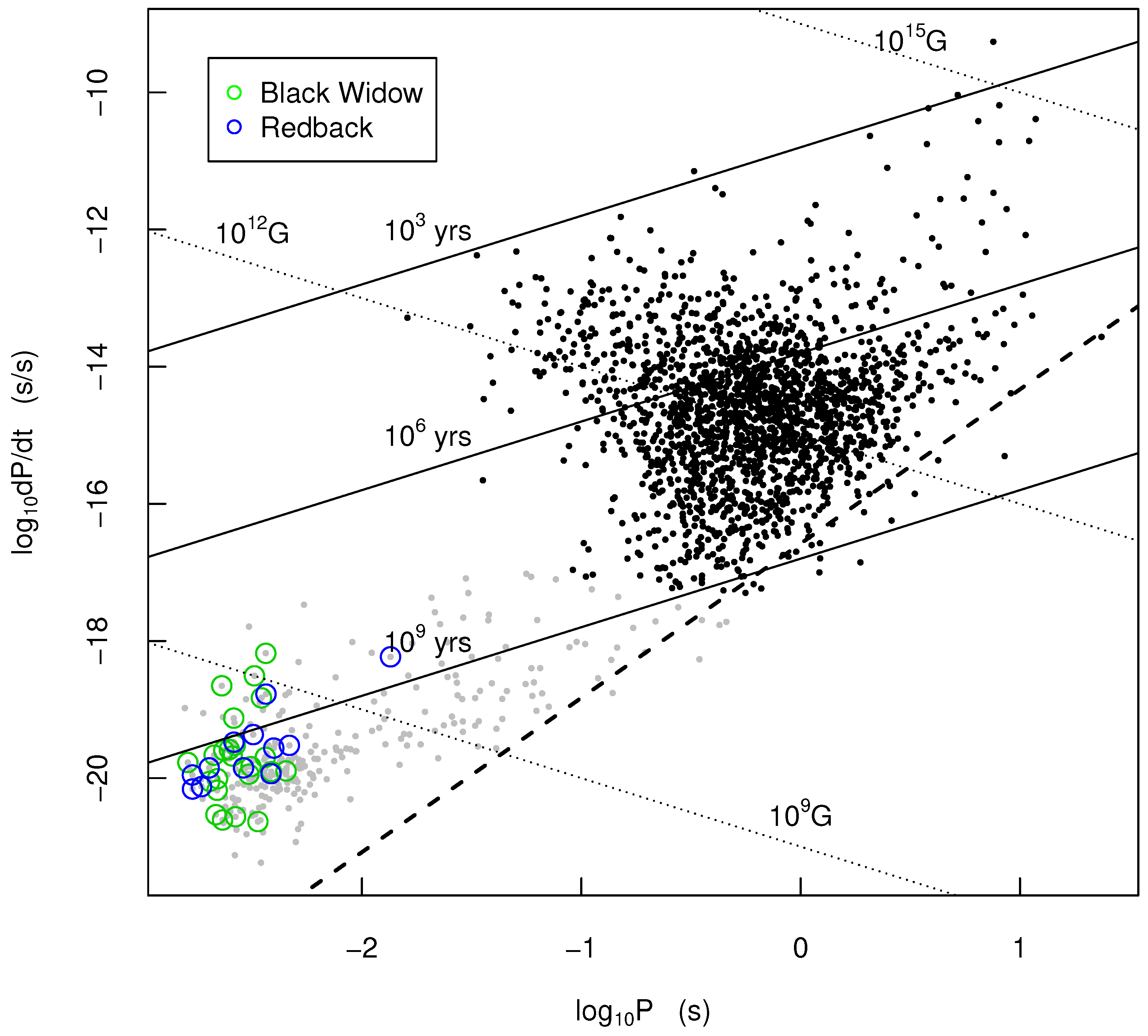
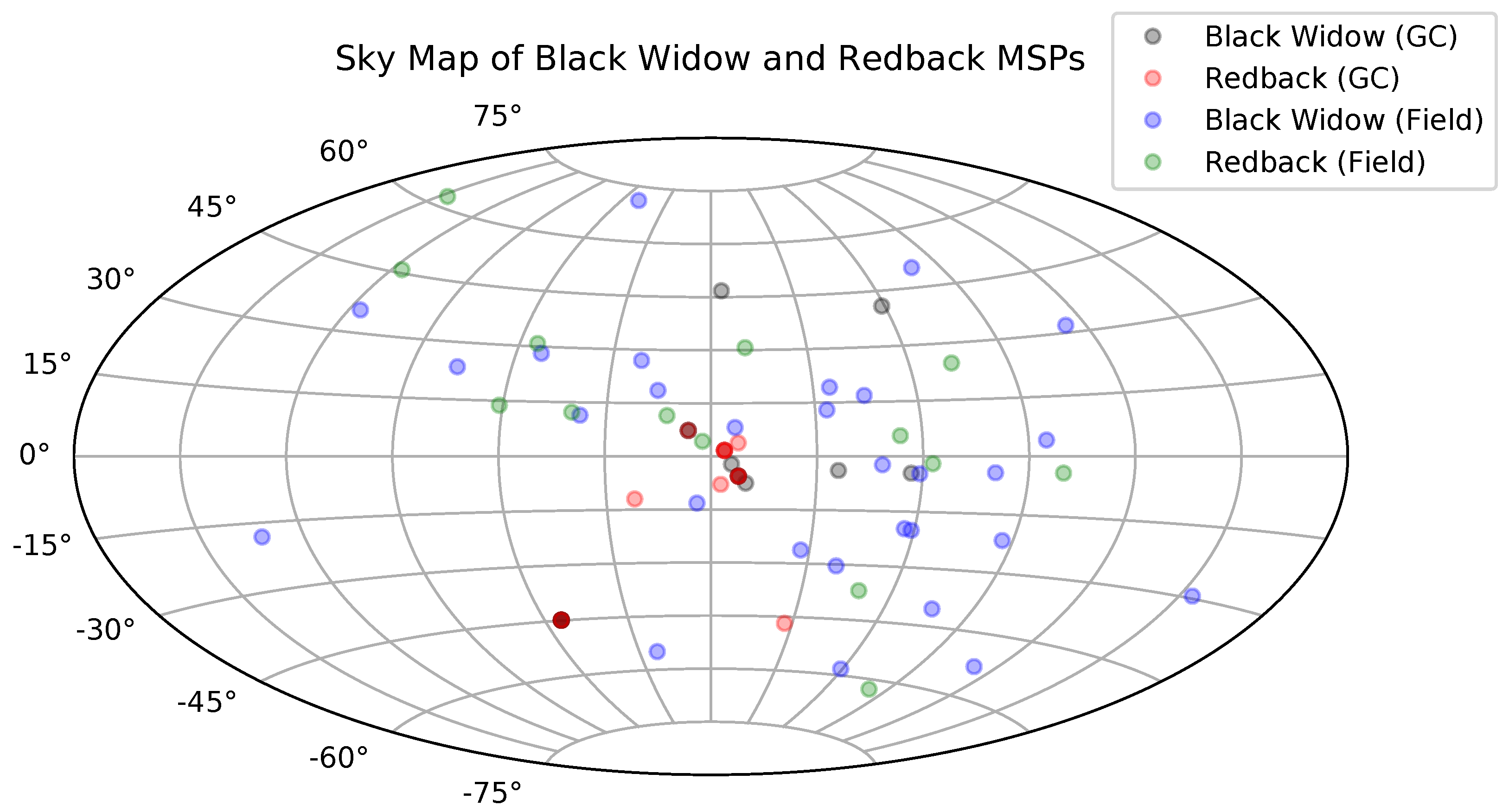
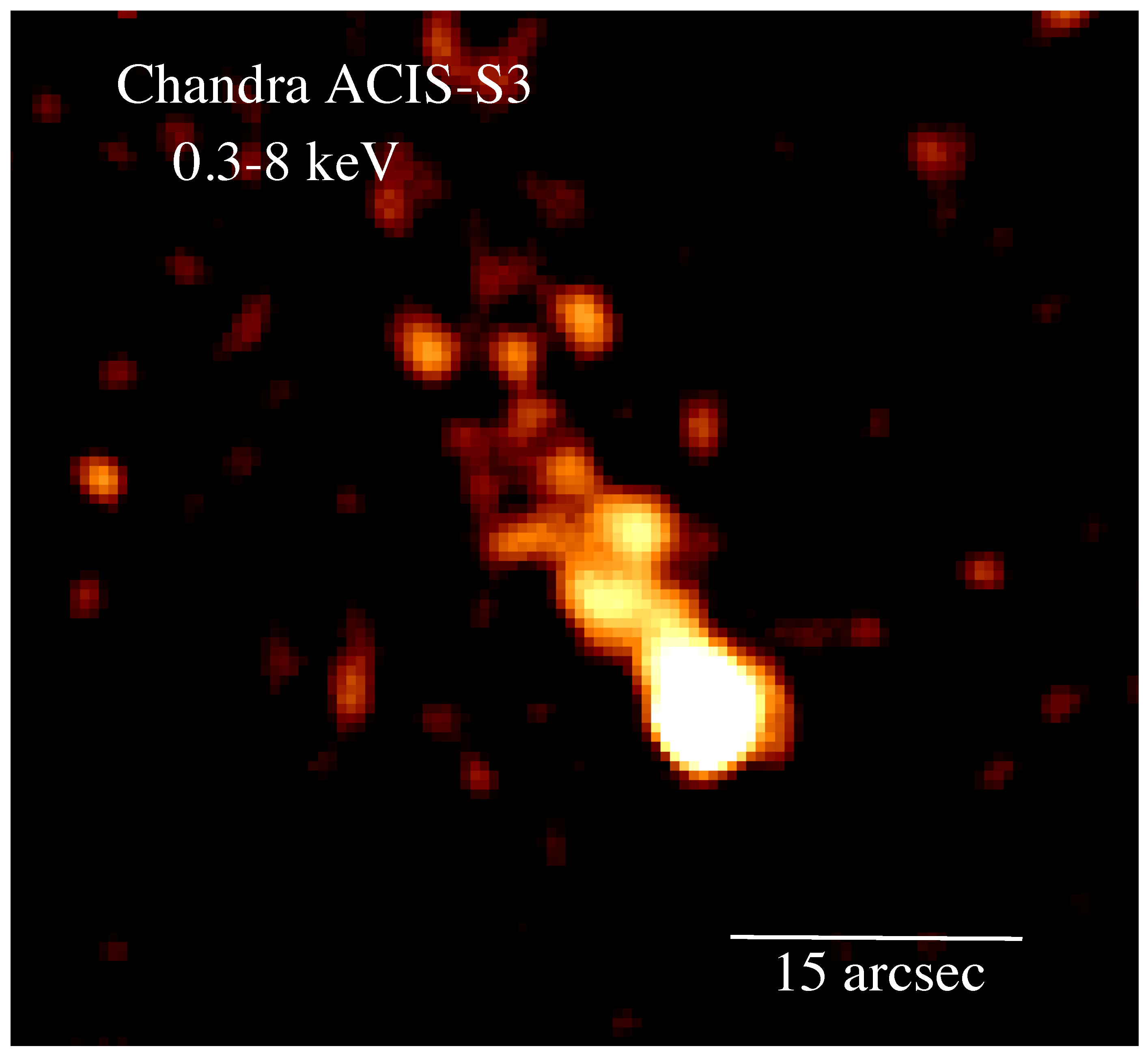
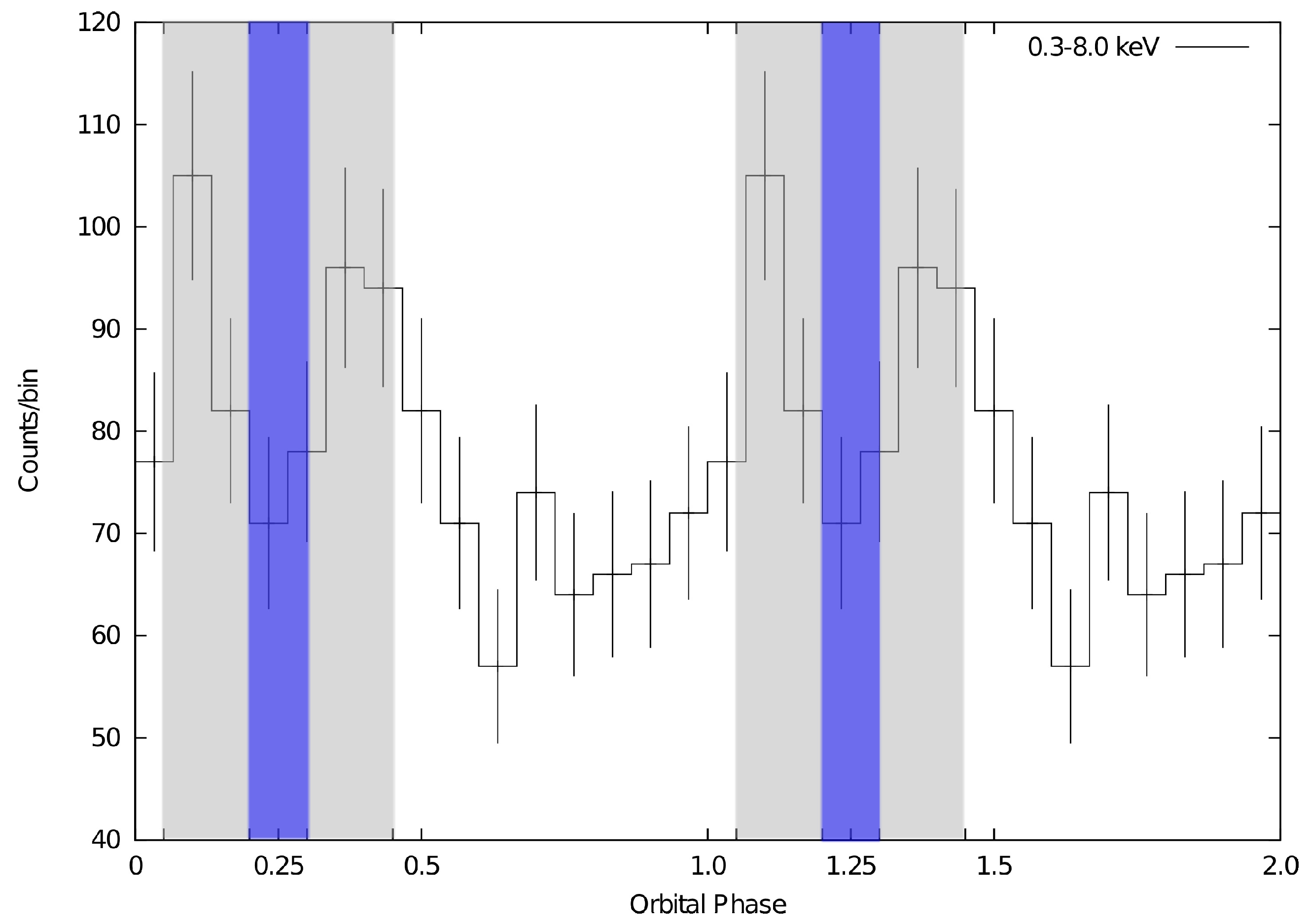
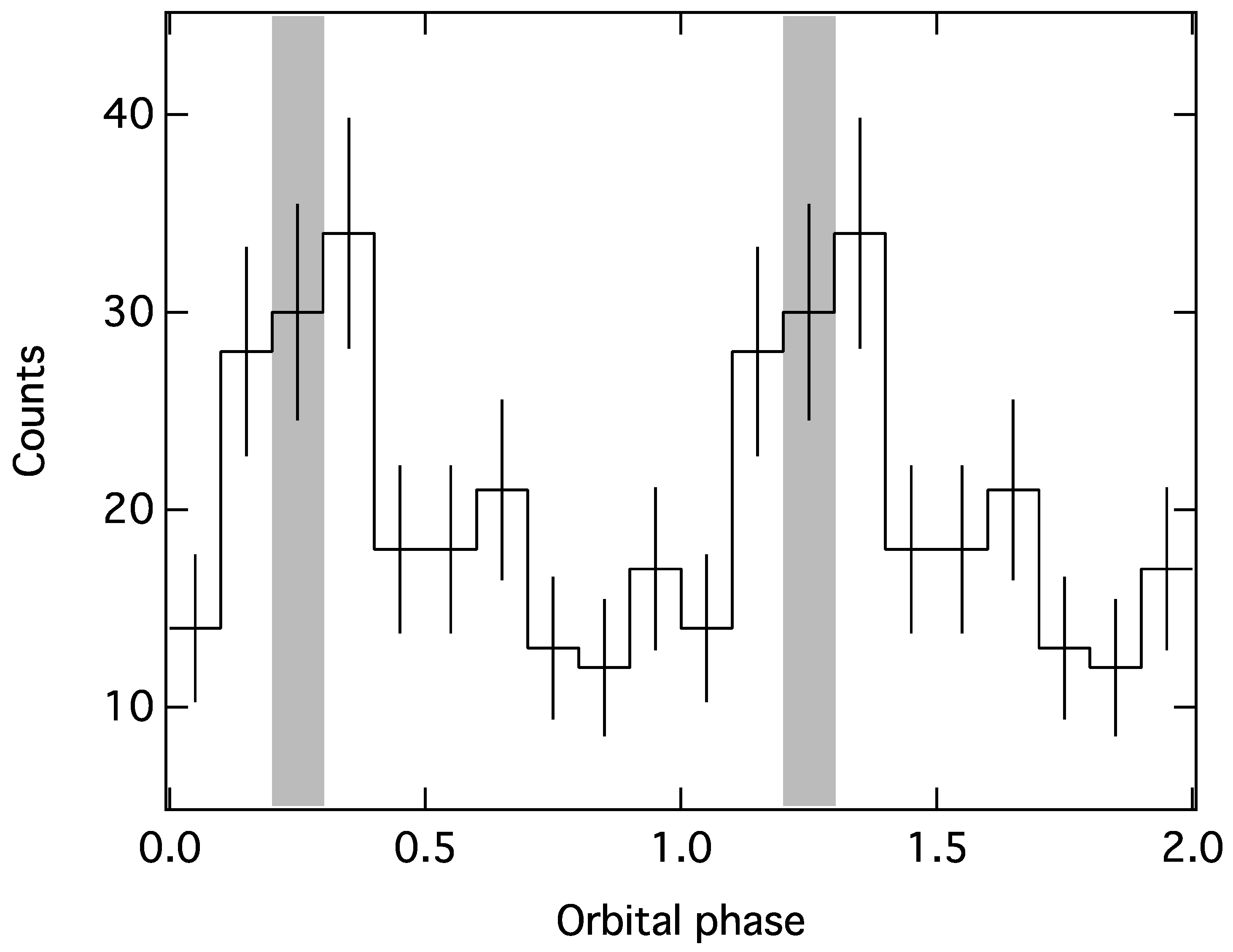
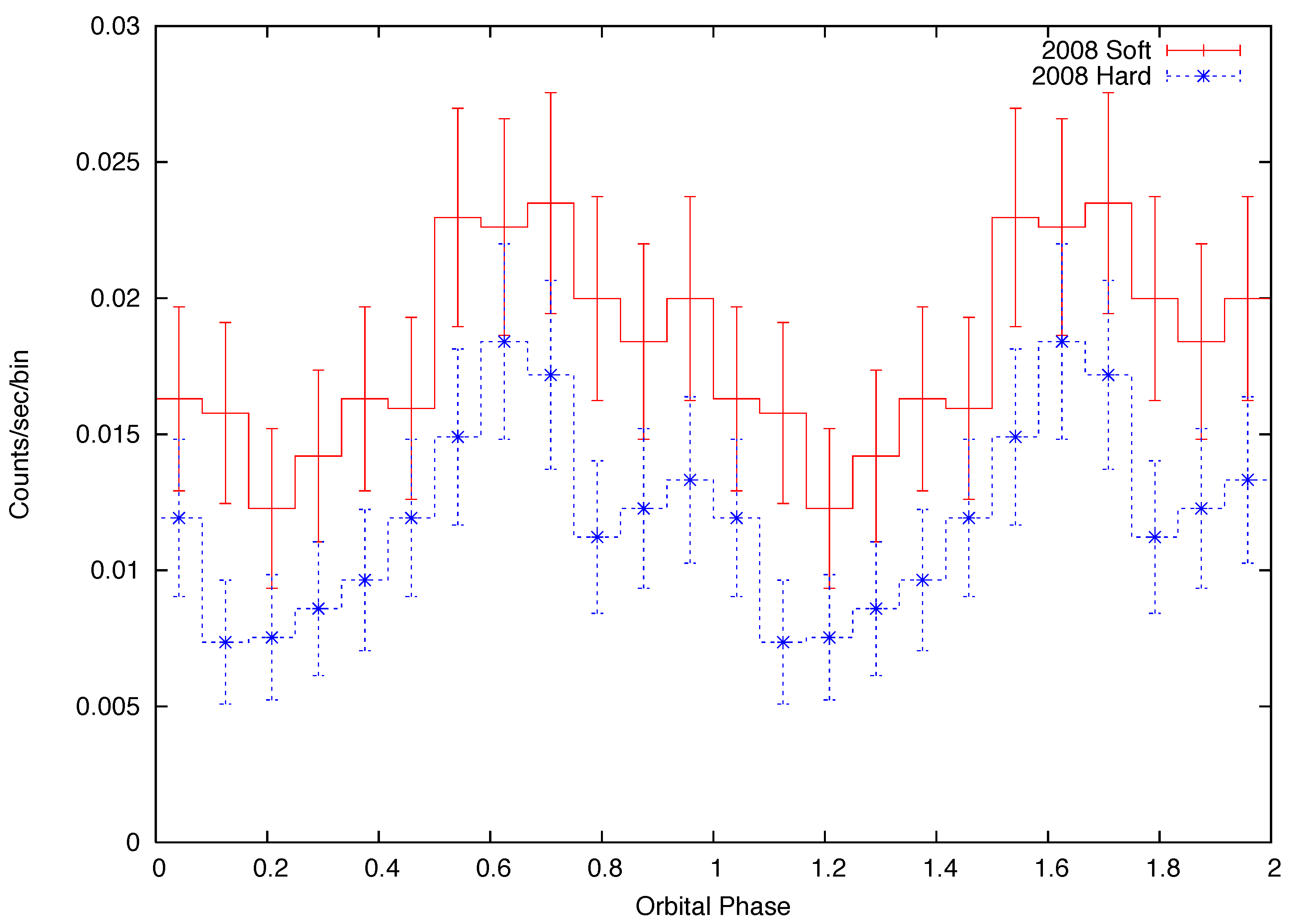
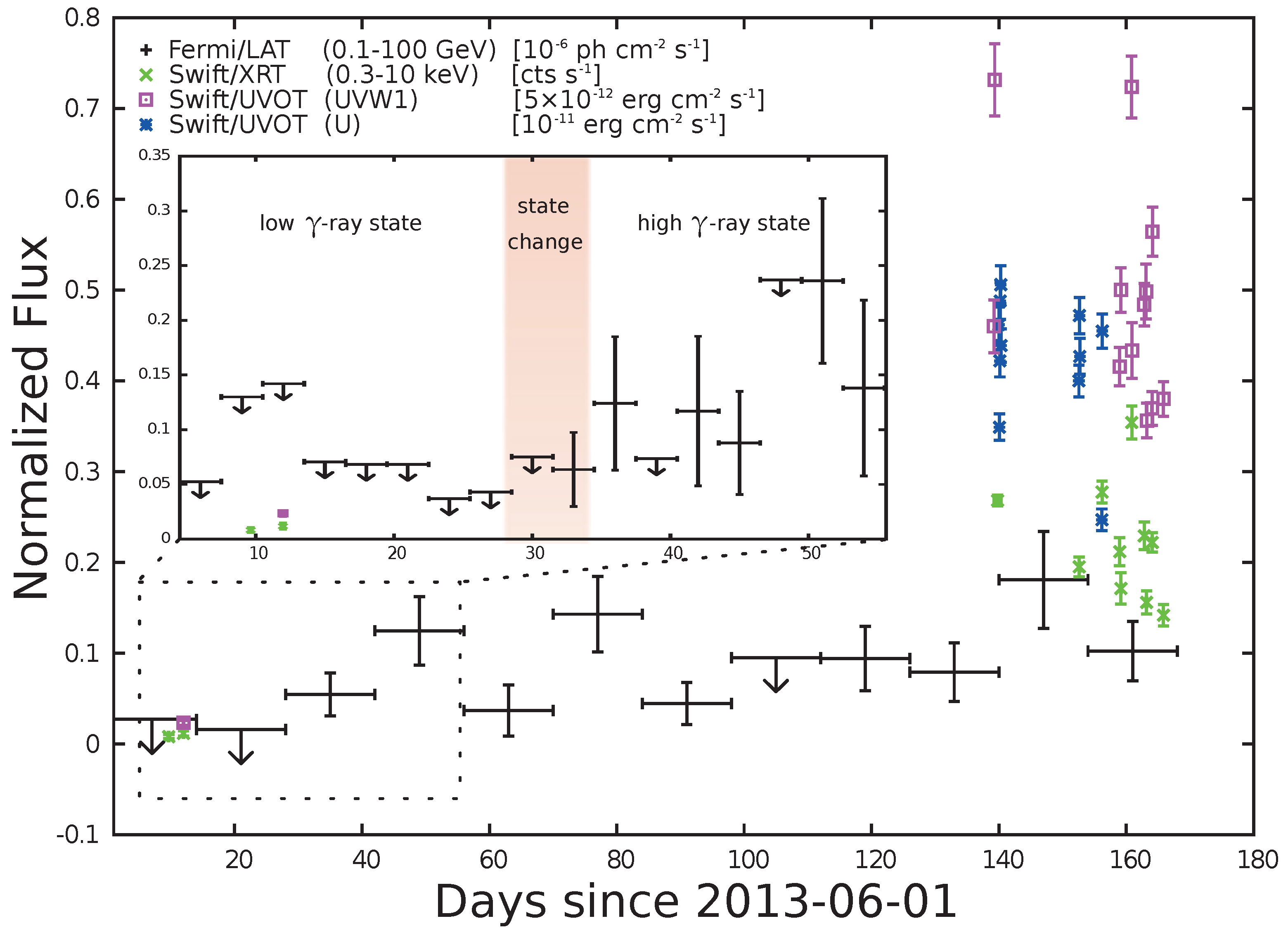
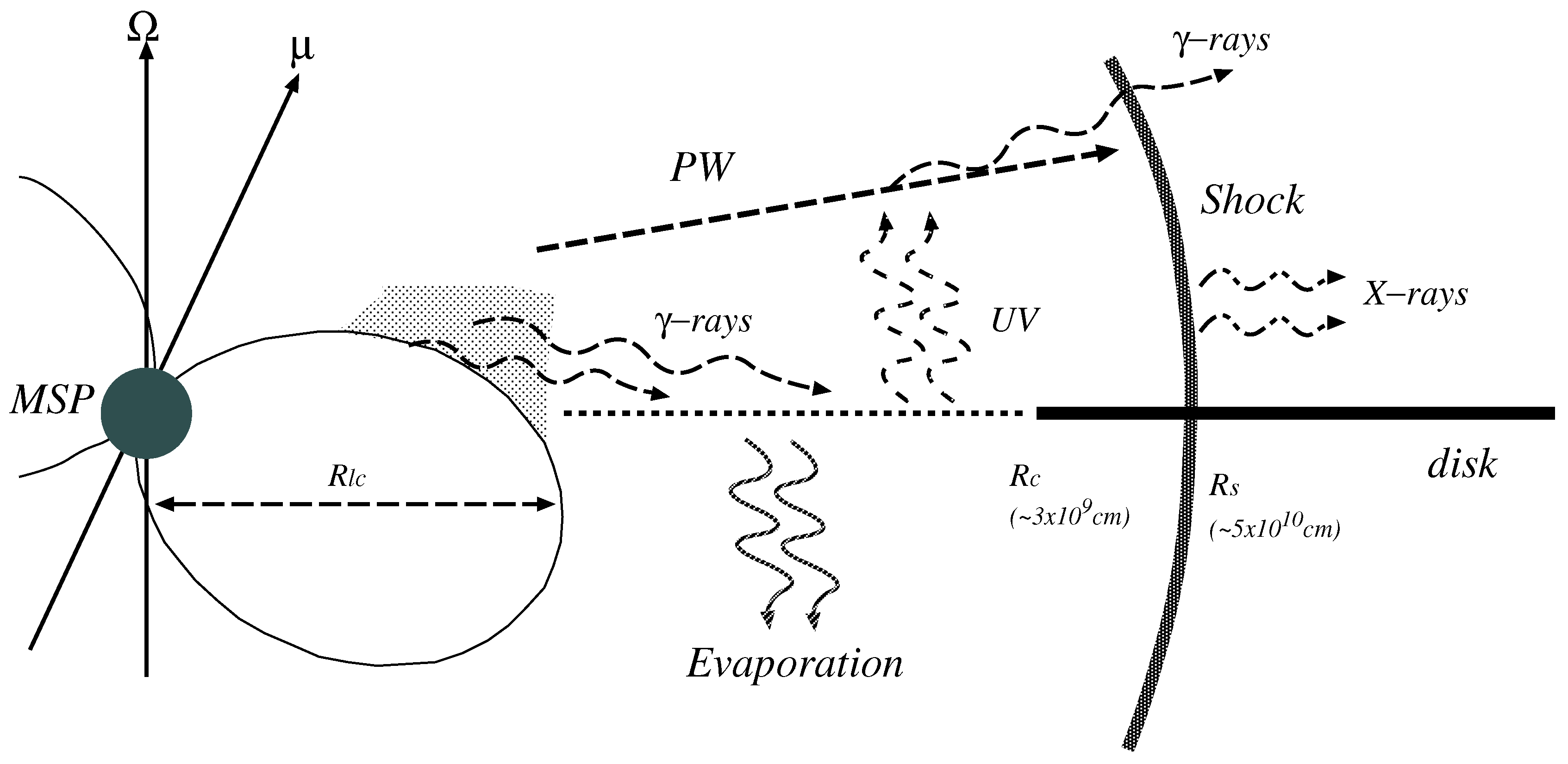
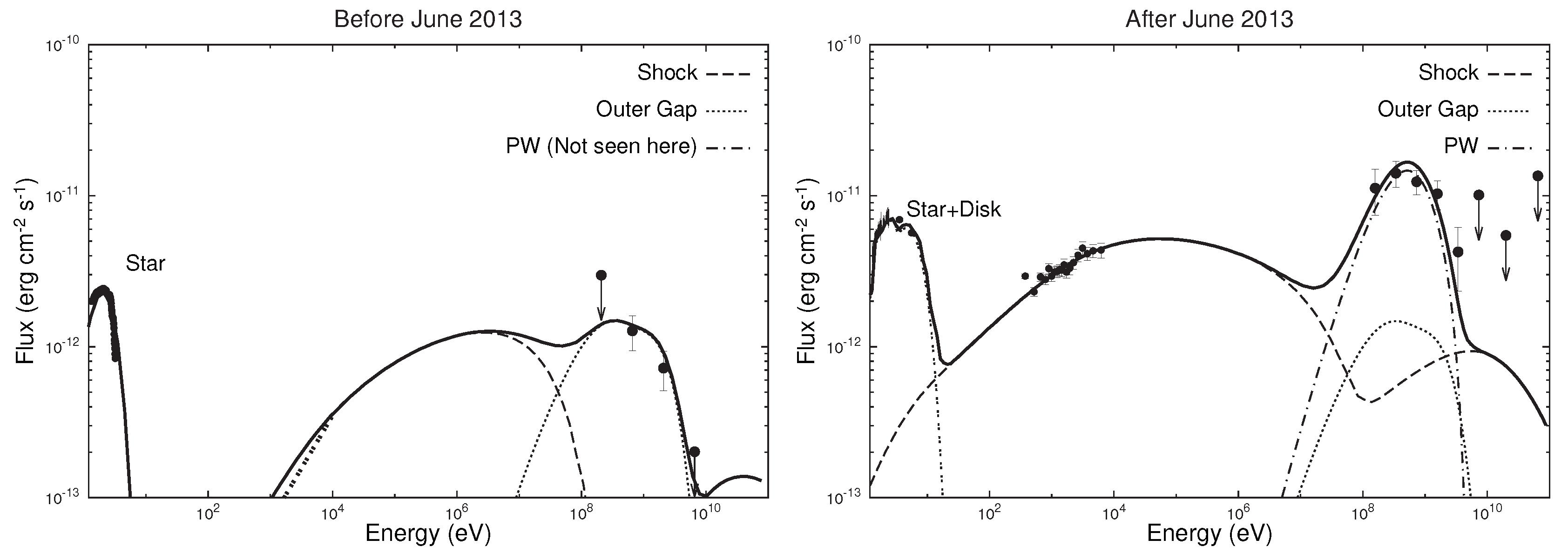
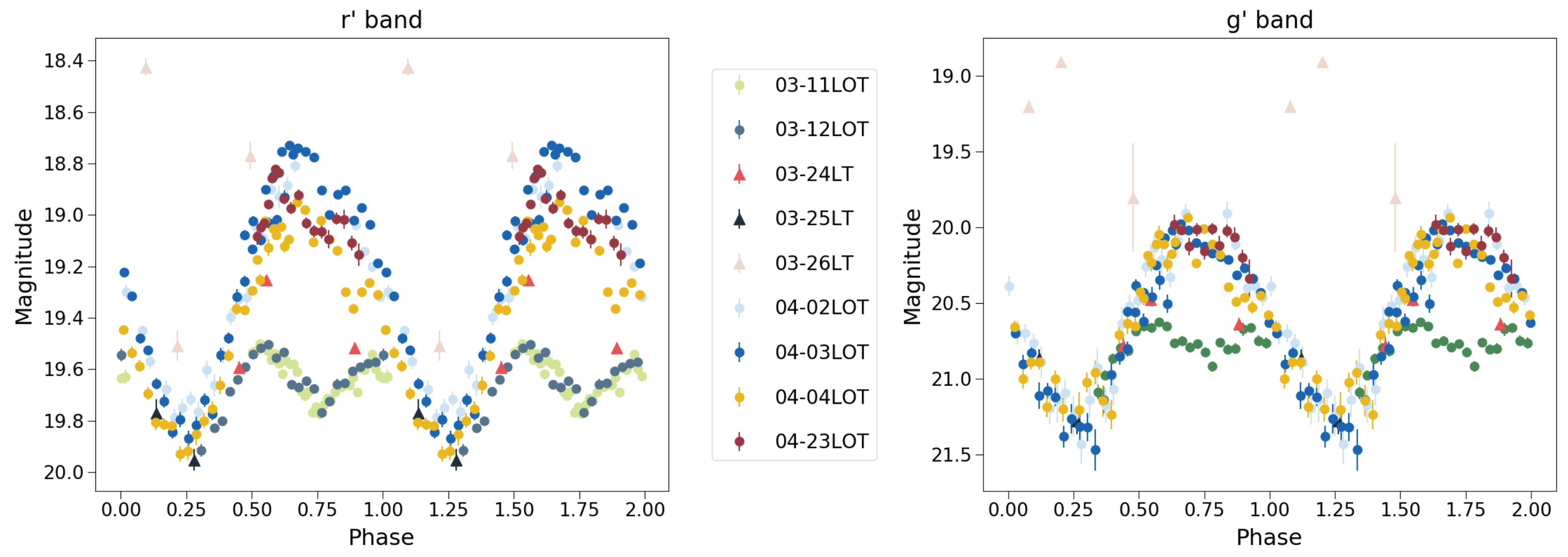
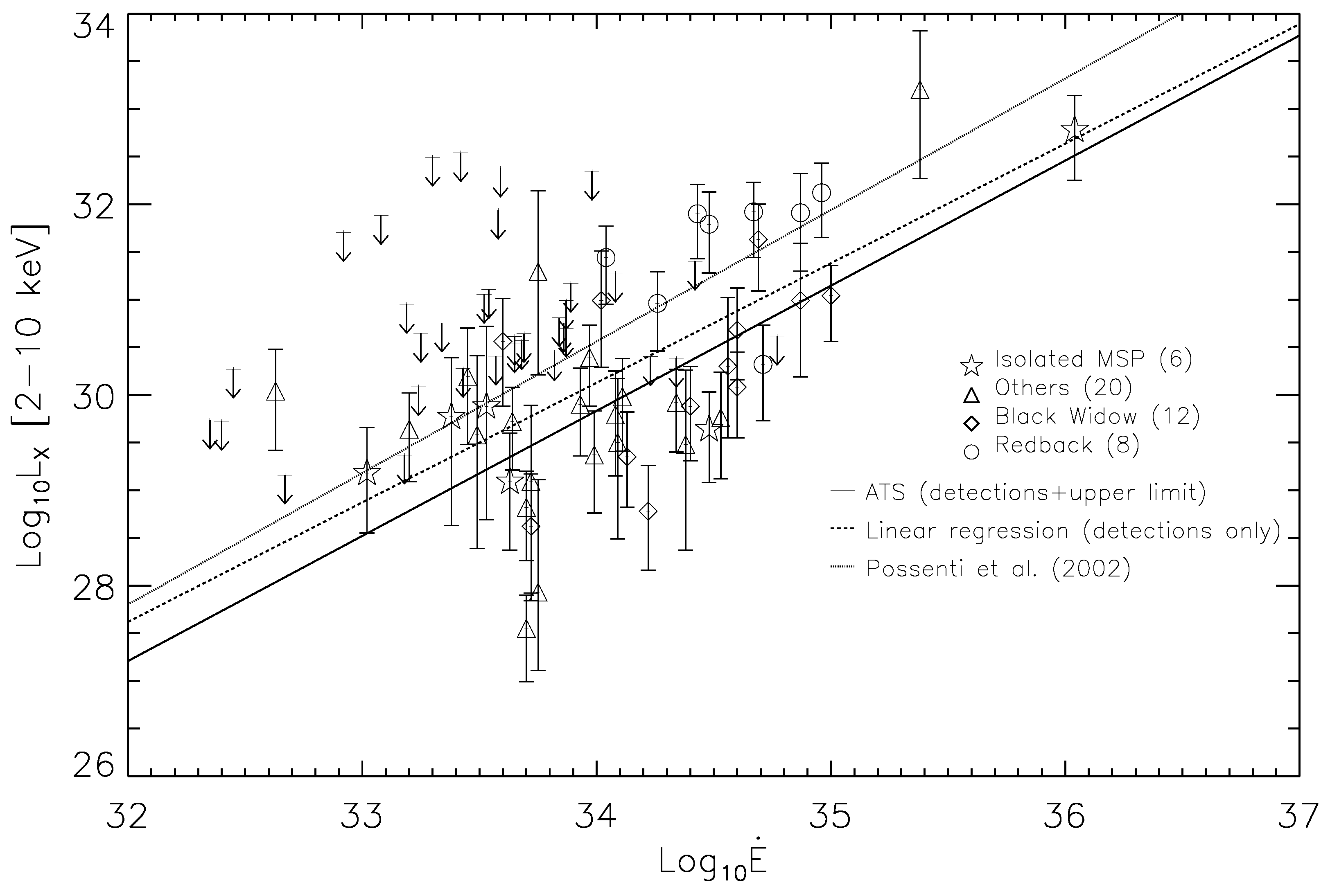
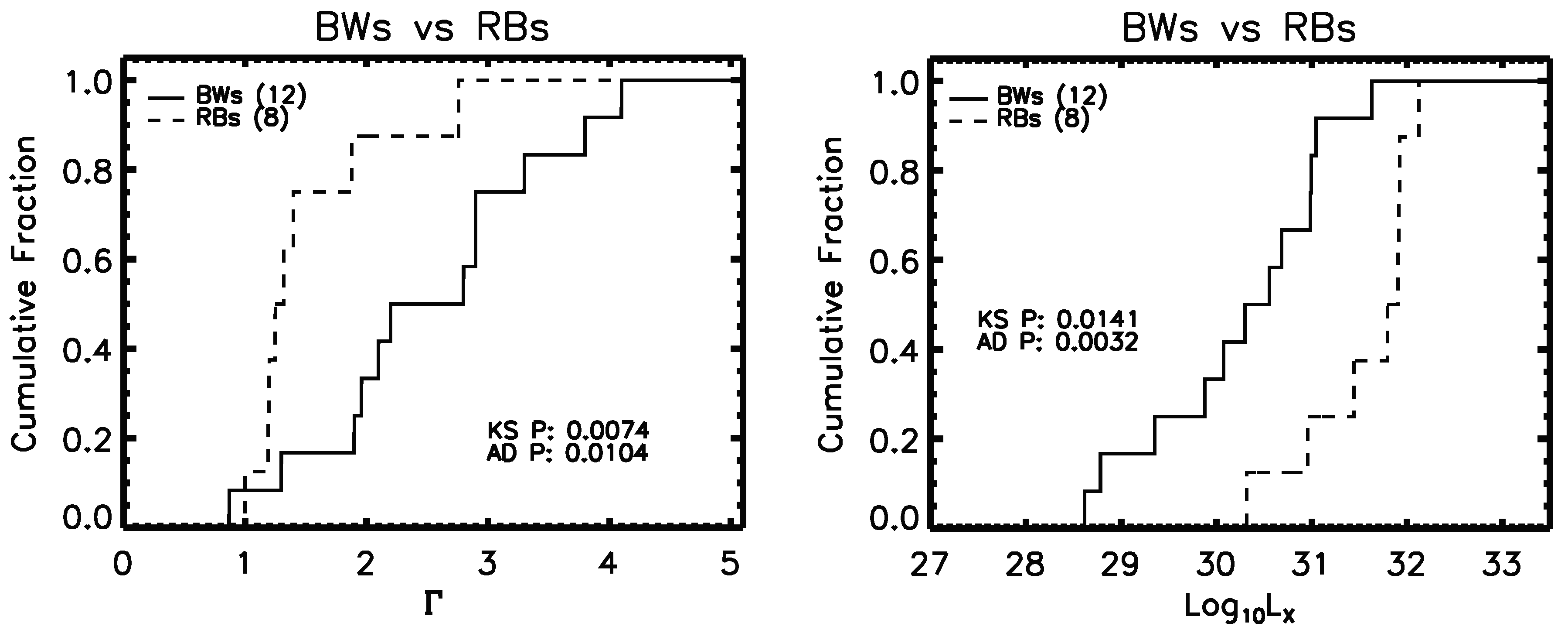
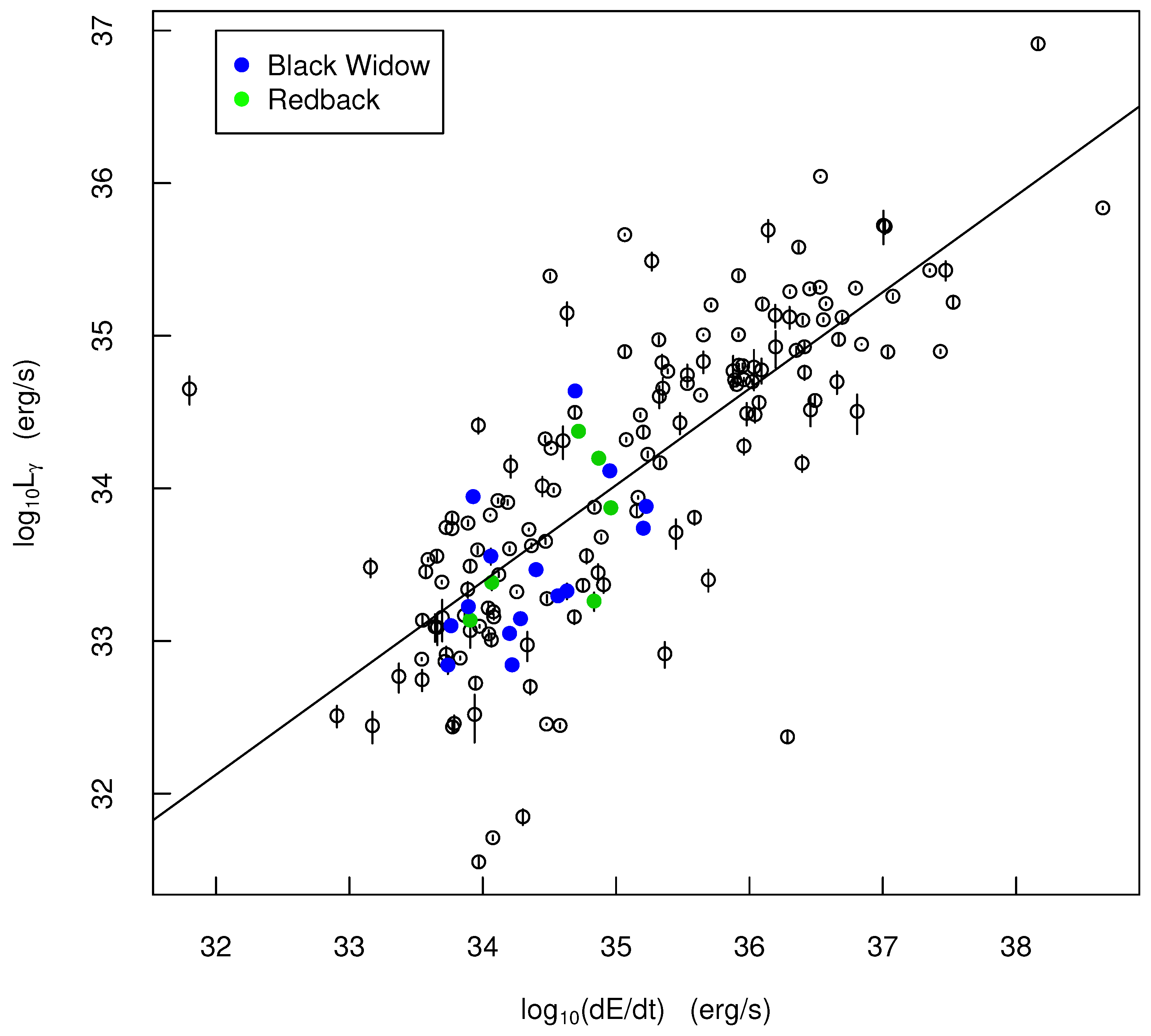
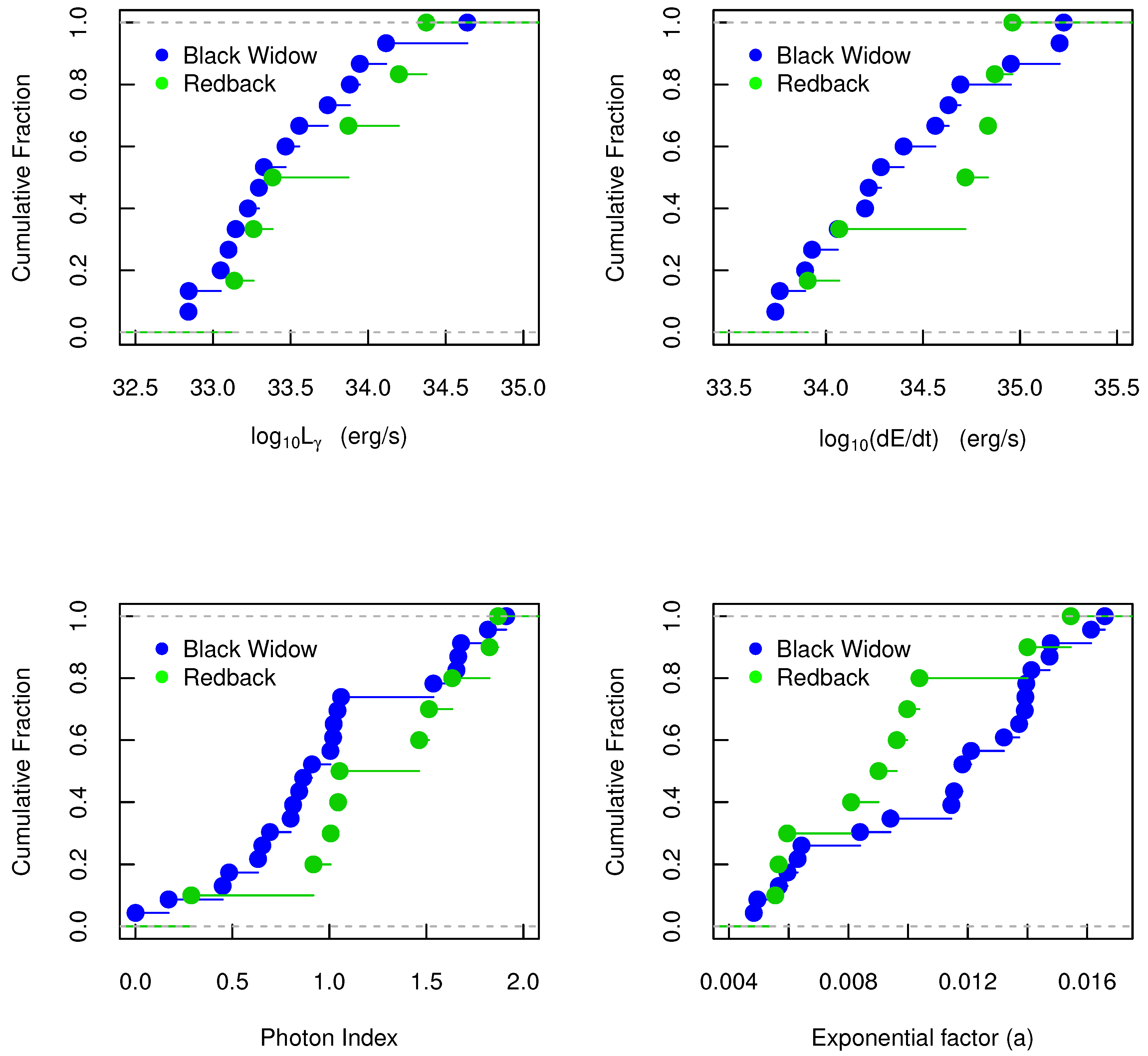
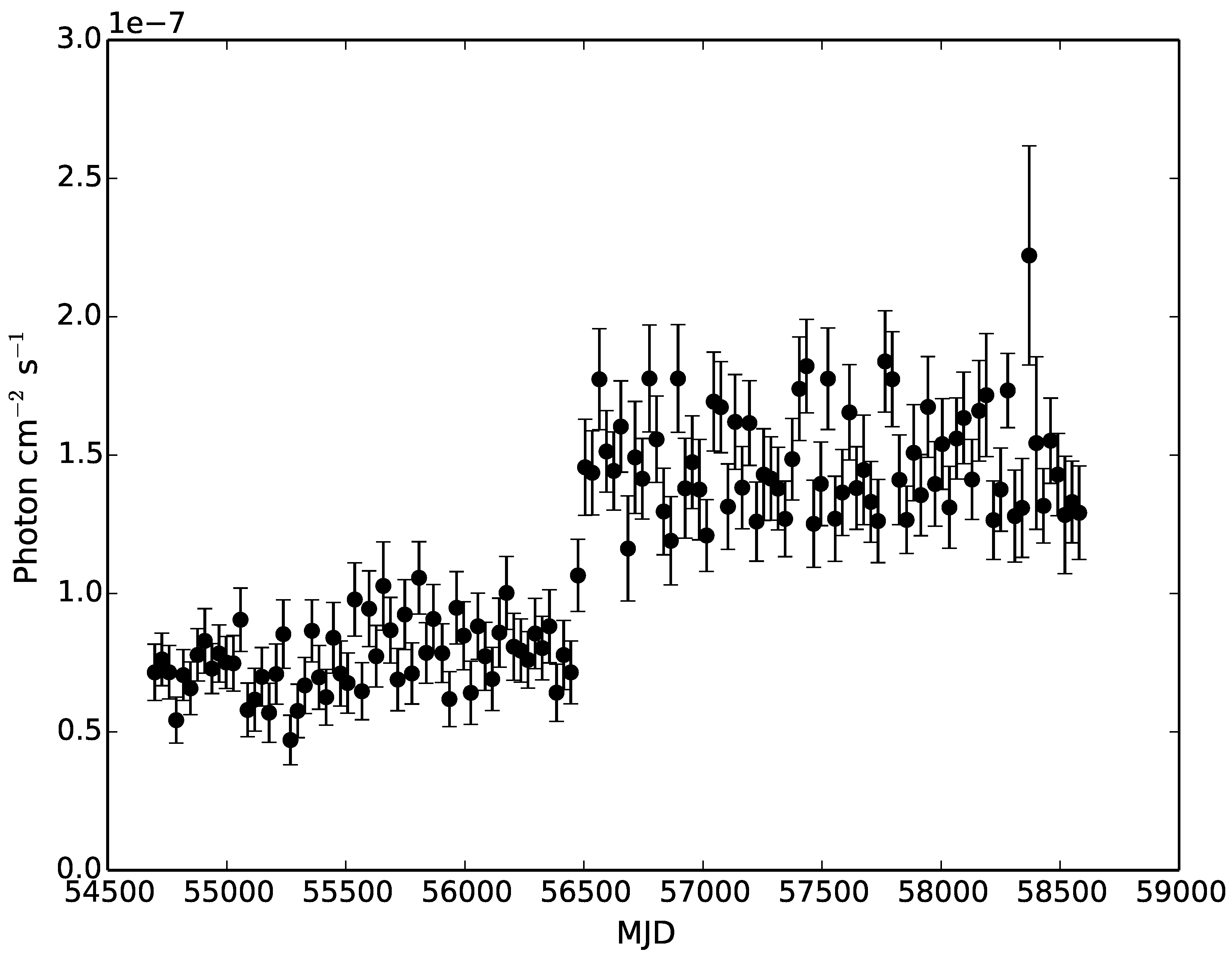
| Name | Type | Spin Period (ms) | Optical | X-Ray | Gamma-Ray | Modulation (1) | Pulsations (2) | References |
|---|---|---|---|---|---|---|---|---|
| J0023+0923 | BW-F | 3.05 | Y | Y | Y | O | RG | [18,19,20] |
| J0251+2606 | BW-F | 3.86 | Y | O | RG | [21,22] | ||
| J0610-2100 | BW-F | 3.86 | Y | Y | o | RG | [23,24] | |
| J0952-0607 | BW-F | 1.41 | Y | Y | Y | O | RG | [22,25,26] |
| J1023+0038 | RB-F | 1.69 | Y | Y | Y | OXg | RGXO | [27,28,29,30,31,32] |
| J1048+2339 | RB-F | 4.67 | Y | Y | Y | OX | RG | [21,33,34] |
| J1124-3653 | BW-F | 2.41 | Y | Y | Ox | RG | [22,35,36] | |
| J1227-4853 | RB-F | 1.69 | Y | Y | Y | Og | RGX | [20,37,38,39,40] |
| J1301+0833 | BW-F | 1.84 | Y | Y | O | RG | [41,42] | |
| J1302-3258 | RB-F | 3.77 | Y | RG | [35] | |||
| J1311-3430 | BW-F | 2.56 | Y | Y | Y | Og | RG | [20,43,44,45] |
| J1431-4715 | RB-F | 2.01 | Y | Y | O | RG | [46,47] | |
| J1446-4701 | BW-F | 2.19 | Y | Y | RG | [20,48] | ||
| J1513-2550 | BW-F | 2.12 | Y | RG | [49] | |||
| J1544+4937 | BW-F | 2.16 | Y | Y | O | RG | [50,51] | |
| J1555-2908 | BW-F | 1.79 | Y | RG | [52] | |||
| J1622-0315 | RB-F | 3.85 | Y | Y | O | RG | [49] | |
| J1628-3205 | RB-F | 3.21 | Y | Y | Y | O | RG | [20,41,42] |
| J1641+8049 | BW-F | 2.02 | Y | Y | RG | [53] | ||
| J1723-2837 | RB-F | 1.86 | Y | Y | oX | R | [54,55] | |
| J1731-1847 | BW-F | 2.34 | Y | Y | R | [20,48] | ||
| J1745+1017 | BW-F | 2.65 | Y | RG | [56] | |||
| J1805+0615 | BW-F | 2.13 | Y | RG | [21] | |||
| J1810+1744 | BW-F | 1.66 | Y | Y | Y | O | RG | [19,20,35] |
| J1816+4510 | RB-F | 3.19 | Y | Y | Y | o | RG | [20,57,58] |
| J1832-38 | BW-F | 1.87 | Y | R | [52] | |||
| J1908+2105 | RB-F | 2.56 | Y | Y | RG | [21,47] | ||
| J1928+1245 | BW-F | 3.02 | Y | R | [59] | |||
| J1957+2516 | RB-F | 3.96 | Y | R | [47,60] | |||
| J1959+2048 | BW-F | 1.61 | Y | Y | Y | OXg | RG | [61,62,63,64] |
| J2017-1614 | BW-F | 2.31 | Y | Y | o | RG | [49] | |
| J2047+1053 | BW-F | 4.29 | Y | Y | RG | [20,41] | ||
| J2051-0827 | BW-F | 4.51 | Y | Y | Y | O | RG | [20,65,66] |
| J2052+1218 | BW-F | 1.99 | Y | O | RG | [21,22] | ||
| J2055+3829 | BW-F | 2.09 | R | [67] | ||||
| J2115+5448 | BW-F | 2.60 | Y | RG | [49] | |||
| J2129-0429 | RB-F | 7.62 | Y | Y | Y | OX | RG | [35,68,69] |
| J2214+3000 | BW-F | 3.12 | Y | Y | Y | O | RG | [18,20,70] |
| J2215+5135 | RB-F | 2.61 | Y | Y | Y | oX | RG | [19,35,36] |
| J2234+0944 | BW-F | 3.63 | Y | RG | [18] | |||
| J2241-5236 | BW-F | 2.19 | Y | Y | Og | RG | [20,22,71,72] | |
| J2256-1024 | BW-F | 2.29 | Y | Y | Y | OX | RG | [19,35,36] |
| J2339-0533 | RB-F | 2.88 | Y | Y | Y | OX | RG | [14,73] |
| Name | Type | Spin Period (ms) | Optical | X-Ray | Gamma-Ray | Modulation (1) | Pulsations (2) | References |
|---|---|---|---|---|---|---|---|---|
| J0024-7204I | BW-GC | 3.48 | Y | R | [74,75] | |||
| J0024-7204J | BW-GC | 2.10 | Y | R | [74,75] | |||
| J0024-7204O | BW-GC | 2.64 | Y | R | [74,75] | |||
| J0024-7204P | BW-GC | 3.64 | R | [74] | ||||
| J0024-7204R | BW-GC | 3.48 | Y | R | [74,75] | |||
| J0024-7204V | RB-GC | 4.81 | R | [74] | ||||
| J0024-7204W | RB-GC | 2.35 | Y | Y | oX | R | [74,76,77] | |
| J1518+0204C | BW-GC | 2.48 | Y | o | R | [78] | ||
| J1641+3627E | BW-GC | 2.49 | R | [79] | ||||
| J1701-3006B | RB-GC | 3.59 | Y | Y | O | R | [75,80,81] | |
| J1701-3006E | BW-GC | 3.23 | R | [80] | ||||
| J1701-3006F | BW-GC | 2.29 | R | [80] | ||||
| J1740-5340 | RB-GC | 3.65 | Y | Y | Ox | R | [75,82,83] | |
| J1748-2021D | RB-GC | 13.50 | R | [84] | ||||
| J1748-2446A | RB-GC | 11.56 | R | [85] | ||||
| J1748-2446O | BW-GC | 1.68 | R | [86] | ||||
| J1748-2446P | RB-GC | 1.73 | R | [86] | ||||
| J1748-2446ad | RB-GC | 1.40 | R | [87] | ||||
| J1807-2459A | BW-GC | 3.06 | R | [80] | ||||
| J1823-3021F | RB-GC | 4.85 | R | [80] | ||||
| J1824-2452G | BW-GC | 5.91 | Y | x | R | [75,88] | ||
| J1824-2452H | RB-GC | 4.63 | Y | Y | Ox | R | [75,88,89] | |
| J1824-2452I | RB-GC | 3.93 | Y | Y | RX | [88,90,91] | ||
| J1824-2452J | BW-GC | 4.04 | R | [88] | ||||
| J1824-2452L | BW-GC | 4.10 | R | [88] | ||||
| J1836-2354A | BW-GC | 3.35 | R | [92] | ||||
| J1911+0102A | BW-GC | 3.62 | R | [93] | ||||
| J1953+1846A | BW-GC | 4.89 | Y | Y | O | R | [75,79,94] | |
| J2140-2310A | RB-GC | 11.02 | R | [95] |
| Name | Orbital Period | Mass Function | X-ray Detection | Accretion | Modulation | References |
|---|---|---|---|---|---|---|
| (day) | () | (Y/N) | (Y/N) | |||
| 3FGL J0212.1+5320 | 0.870 | 0.88 | Y | N | Ox | [122,123] |
| 3FGL J0427.9−6704 | 0.367 | 0.96 | Y | Y | OXg | [124] |
| 1FGL J0523.5−2529 | 0.688 | 0.49 | Y | N | Og | [125,126] |
| 3FGL J0744.1−2523 | 0.115 | N | N | O | [127] | |
| 3FGL J0802.3−5610 | 0.416 | Y | N | O | [127] | |
| 3FGL J0838.8−2829 | 0.215 | 0.69 | Y | N | O | [128] |
| 2FGL J0846.0+2820 | 8.133 | 0.14 | N | Y? | o | [129] |
| 3FGL J0954.8−3948 | 0.387 | 0.81 | Y | N | Ox | [130] |
| FL8Y J1109.8−6500 | Y | Y | [131] | |||
| 3FGL J1544.6−1125 | 0.242 | 0.0015 | Y | Y | O | [132,133] |
| 2FGL J1653.6−0159 | 0.052 | 1.60 | Y | N | Ox | [134,135] |
| 3FGL J2039.6−5618 | 0.228 | 0.80 | Y | N | OXg | [47,136,137,138] |
© 2019 by the authors. Licensee MDPI, Basel, Switzerland. This article is an open access article distributed under the terms and conditions of the Creative Commons Attribution (CC BY) license (http://creativecommons.org/licenses/by/4.0/).
Share and Cite
Hui, C.Y.; Li, K.L. High Energy Radiation from Spider Pulsars. Galaxies 2019, 7, 93. https://doi.org/10.3390/galaxies7040093
Hui CY, Li KL. High Energy Radiation from Spider Pulsars. Galaxies. 2019; 7(4):93. https://doi.org/10.3390/galaxies7040093
Chicago/Turabian StyleHui, Chung Yue, and Kwan Lok Li. 2019. "High Energy Radiation from Spider Pulsars" Galaxies 7, no. 4: 93. https://doi.org/10.3390/galaxies7040093
APA StyleHui, C. Y., & Li, K. L. (2019). High Energy Radiation from Spider Pulsars. Galaxies, 7(4), 93. https://doi.org/10.3390/galaxies7040093





